Powerful online learning at your pace


Problem-Solving vs Word Problems
I remember preparing for an interview for my first teaching position in the 90’s. I was told that I would likely be asked to explain my approach to teaching problem-solving. I jumped on the Internet to research problem-solving and craft my response. What I found was that problem-solving in math basically meant teaching students to solve word problems. I ended up getting the job and, for a number of years, taught what I thought was problem-solving. What I’ve come to find out, however, is that while we certainly need to teach students strategies for solving word problems, problem-solving is so much more than solving word problems.
Problem-Solving > Word Problems
Think for a minute about a problem you’ve solved recently. I’ll give you a personal example. My current car lease ends next month, and I have to decide what to do. Usually, I just turn in my old car and lease another one. This year, however, is different. We are in the midst of an unprecedented shortage of new cars, driving new car prices way up. Not the best time to buy or lease a new car. At the same time, used car prices are surging and many used cars are selling at close to their original MSRP. Once again I jumped on the Internet to research the situation. I found out that I might be able to purchase my car at lease-end and turn around and sell it at a higher price! But that would leave me without a car. So, I have decided to purchase my car at lease-end and hold onto it until new car prices start to come back down. I should still get a trade-in value on my current car higher than what it will cost me to purchase it at lease-end. Of course, all this sounds great in theory and seems to be the right decision based on the data, but I won’t really know if I made the best decision until sometime next year.
This post contains affiliate links, which simply means that when you use my link and purchase a product, I receive a small commission. There is no additional cost to you, and I only link to books and products that I personally use and recommend.
I think you’d agree that what I described was some heavy-duty problem-solving with pretty significant consequences. Yet not a word problem in sight. You see, true problem-solving is messy and goes way beyond solving word problems.
George Polya is often called the Father of Problem-Solving. In 1945, he outlined a 4-step process for solving problems in his ground-breaking book How to Solve It . You can see the four steps pictured below.

Now think about the process I went through while solving my car problem. Don’t you see the four steps in what I did?
The problem is that well-intentioned teachers have tried to turn the problem-solving process, which is inherently messy, into an algorithm—if you do these steps, then you can easily solve problems. This is why we see students boxing numbers, underlining questions, and looking for “key” words, all shortcuts that basically give students permission to not read and understand word problems.
So how do we teach students to become problem solvers? Well, it might sound simplistic, but we give them rich problems to solve and get out of the way. Again, with the best of intentions, teachers often provide too much support and students come to depend on it.
I recently facilitated a book study on the book Productive Math Struggle: A 6-Point Action Plan for Fostering Perseverance , by John J. SanGiovanni, Susie Katt, and Kevin J. Dykema. It is a fabulously useful and easy-to-read book, chock full of implementable ideas. In other words, it’s a book you will use and not just read. It’s no coincidence that the first three chapters all deal with creating a climate where productive struggle can thrive. Let’s face it, many math classrooms still run on the premise that math is about regurgitating a memorized procedure. Not much thinking involved. First, we as teachers need to embrace the idea of teaching through productive struggle. Then, we need to set students up for success as we introduce struggle into our lessons.
One way to increase productive struggle and thinking in our classroom is to flip the sequence of our instruction. Rather than the traditional direct teaching approach of I do, We do, and You do , we flip the process so students are given a problem to solve before direct instruction.
Here’s an example. Say students have been using a part/whole diagram to represent join/result unknown word problems . So they have been practicing identifying if each number in a word problem represents one of the parts or the whole and creating part/whole diagrams, such as this one. By looking at the diagram, you can probably construct the word problem they were solving, right?

Now you would like to introduce a new structure—join/change unknown. It’s a more complicated type of problem. Here’s an example of this type of problem.
Mariana had $20. Her grandmother gave her some money for her birthday. Now Mariana has $28. How much money did Mariana’s grandmother give her for her birthday?
I could proceed to teach this new structure with a scripted lesson: Boys and girls, you have been using a diagram to solve join/result unknown problems. Today, I’m going to show you how to use the diagram to solve a new structure—Join/change unknown. I would model a problem or two, we would work a couple together, and then they could practice more on their own. A typical I do, We do, You do lesson.
But instead, what if we read the new problem out loud together, and then I commented, Huh. This problem sounds a little different. Work with a partner to see if you can solve it using your part/whole diagram. In other words, the You do comes first! Would every pair of students be successful in solving the problem? Probably not. But after all students have the opportunity to struggle with it, think of the rich discussions we can have. It’s likely that at least some students will determine that it’s a new structure and then I can come along behind and put a name to it.

So I hope you will commit to thinking of problem-solving as something beyond just solving word problems and give students the opportunity to productively struggle in your classroom. I think you’ll see engagement soar!
If you want more information on addition/subtraction structures check out this post .

Similar Posts

Would You Rather…Fractions
A common misconception students have about fractions is that a larger denominator means a larger fraction. Ask a handful of third graders (or 4th graders or 5th graders…) which fraction…

More Mental Math Strategies
After a recent post on addition strategies, I had a reader email me and ask about subtraction strategies. She was working with her daughter on homework, and while she understood…

Concrete Learning for One More and One Less
Last week I shared an activity for practicing one more and one less than a number. Tonight I wanted to talk a little about the CRA (concrete, representational, abstract) sequence…

Turn Worksheets into Workstations
I understand the allure of worksheets. Really I do. Students need practice with new concepts, and worksheets provide an easy vehicle for that practice. Worksheets are low maintenance. You just…

Multiplying Fractions by a Whole Number
Newer standards require students to multiply a whole number by a fraction in 5th Grade. Here are some things to keep in mind when introducing this skill: Remind students about…

Fact Practice Your Students Will Love!
Kids are competitive. Heck, adults are competitive. Add a little competition to your fact practice activities and you’re sure to have a hit on your hands. I call this game…
Cy Fair does model drawing!! It works
Howdy, neighbor! Yes, model drawing is so powerful. I’m looking forward to next year when this whole group comes up knowing it!
I’ve been using model drawing with my first graders and it’s been powerful to see how they understand what’s happening in the problem, especially those tricky missing addend problems. This is the most confident I’ve felt with first graders and problems in a very long time!
I totally agree, Nilda! It really helps them to visualize the math that is happening in the story!
Looks like a great lesson!
Tara The Math Maniac
Thanks, Tara!
Hi Donna I am a math coach in Massachusetts and want institute bar models in all grade levels, K-5, for the 2017-2018 school year. Can you recommend a resource for me to use for research prior to professional development? Thanks Meg
A book that I have used and think is a great resource is Char Forsten’s book on model drawing .
Leave a Reply Cancel reply
Your email address will not be published. Required fields are marked *

- Get started with computers
- Learn Microsoft Office
- Apply for a job
- Improve my work skills
- Design nice-looking docs
- Getting Started
- Smartphones & Tablets
- Typing Tutorial
- Online Learning
- Basic Internet Skills
- Online Safety
- Social Media
- Zoom Basics
- Google Docs
- Google Sheets
- Career Planning
- Resume Writing
- Cover Letters
- Job Search and Networking
- Business Communication
- Entrepreneurship 101
- Careers without College
- Job Hunt for Today
- 3D Printing
- Freelancing 101
- Personal Finance
- Sharing Economy
- Decision-Making
- Graphic Design
- Photography
- Image Editing
- Learning WordPress
- Language Learning
- Critical Thinking
- For Educators
- Translations
- Staff Picks
- English expand_more expand_less
Algebra Topics - Introduction to Word Problems
Algebra topics -, introduction to word problems, algebra topics introduction to word problems.

Algebra Topics: Introduction to Word Problems
Lesson 9: introduction to word problems.
/en/algebra-topics/solving-equations/content/
What are word problems?
A word problem is a math problem written out as a short story or scenario. Basically, it describes a realistic problem and asks you to imagine how you would solve it using math. If you've ever taken a math class, you've probably solved a word problem. For instance, does this sound familiar?
Johnny has 12 apples. If he gives four to Susie, how many will he have left?
You could solve this problem by looking at the numbers and figuring out what the problem is asking you to do. In this case, you're supposed to find out how many apples Johnny has left at the end of the problem. By reading the problem, you know Johnny starts out with 12 apples. By the end, he has 4 less because he gave them away. You could write this as:
12 - 4 = 8 , so you know Johnny has 8 apples left.
Word problems in algebra
If you were able to solve this problem, you should also be able to solve algebra word problems. Yes, they involve more complicated math, but they use the same basic problem-solving skills as simpler word problems.
You can tackle any word problem by following these five steps:
- Read through the problem carefully, and figure out what it's about.
- Represent unknown numbers with variables.
- Translate the rest of the problem into a mathematical expression.
- Solve the problem.
- Check your work.
We'll work through an algebra word problem using these steps. Here's a typical problem:
The rate to rent a small moving van is $30 per day, plus $0.50 per mile. Jada rented a van to drive to her new home. It took two days, and the van cost $360. How many miles did she drive?
It might seem complicated at first glance, but we already have all of the information we need to solve it. Let's go through it step by step.
Step 1: Read through the problem carefully.
With any problem, start by reading through the problem. As you're reading, consider:
- What question is the problem asking?
- What information do you already have?
Let's take a look at our problem again. What question is the problem asking? In other words, what are you trying to find out?
The rate to rent a small moving van is $30 per day, plus $0.50 per mile. Jada rented a van to drive to her new home. It took 2 days, and the van cost $360. How many miles did she drive?
There's only one question here. We're trying to find out how many miles Jada drove . Now we need to locate any information that will help us answer this question.
There are a few important things we know that will help us figure out the total mileage Jada drove:
- The van cost $30 per day.
- In addition to paying a daily charge, Jada paid $0.50 per mile.
- Jada had the van for 2 days.
- The total cost was $360 .
Step 2: Represent unknown numbers with variables.
In algebra, you represent unknown numbers with letters called variables . (To learn more about variables, see our lesson on reading algebraic expressions .) You can use a variable in the place of any amount you don't know. Looking at our problem, do you see a quantity we should represent with a variable? It's often the number we're trying to find out.
Since we're trying to find the total number of miles Jada drove, we'll represent that amount with a variable—at least until we know it. We'll use the variable m for miles . Of course, we could use any variable, but m should be easy to remember.
Step 3: Translate the rest of the problem.
Let's take another look at the problem, with the facts we'll use to solve it highlighted.
The rate to rent a small moving van is $30 per day , plus $0.50 per mile . Jada rented a van to drive to her new home. It took 2 days , and the van cost $360 . How many miles did she drive?
We know the total cost of the van, and we know that it includes a fee for the number of days, plus another fee for the number of miles. It's $30 per day, and $0.50 per mile. A simpler way to say this would be:
$30 per day plus $0.50 per mile is $360.
If you look at this sentence and the original problem, you can see that they basically say the same thing: It cost Jada $30 per day and $0.50 per mile, and her total cost was $360 . The shorter version will be easier to translate into a mathematical expression.
Let's start by translating $30 per day . To calculate the cost of something that costs a certain amount per day, you'd multiply the per-day cost by the number of days—in other words, 30 per day could be written as 30 ⋅ days, or 30 times the number of days . (Not sure why you'd translate it this way? Check out our lesson on writing algebraic expressions .)
$30 per day and $.50 per mile is $360
$30 ⋅ day + $.50 ⋅ mile = $360
As you can see, there were a few other words we could translate into operators, so and $.50 became + $.50 , $.50 per mile became $.50 ⋅ mile , and is became = .
Next, we'll add in the numbers and variables we already know. We already know the number of days Jada drove, 2 , so we can replace that. We've also already said we'll use m to represent the number of miles, so we can replace that too. We should also take the dollar signs off of the money amounts to make them consistent with the other numbers.
30 ⋅ 2 + .5 ⋅ m = 360
Now we have our expression. All that's left to do is solve it.
Step 4: Solve the problem.
This problem will take a few steps to solve. (If you're not sure how to do the math in this section, you might want to review our lesson on simplifying expressions .) First, let's simplify the expression as much as possible. We can multiply 30 and 2, so let's go ahead and do that. We can also write .5 ⋅ m as 0.5 m .
60 + .5m = 360
Next, we need to do what we can to get the m alone on the left side of the equals sign. Once we do that, we'll know what m is equal to—in other words, it will let us know the number of miles in our word problem.
We can start by getting rid of the 60 on the left side by subtracting it from both sides .
| 60 | + .5m = | 360 |
| -60 | -60 |
The only thing left to get rid of is .5 . Since it's being multiplied with m , we'll do the reverse and divide both sides of the equation with it.
| .5m | = | 300 |
| .5 | .5 |
.5 m / .5 is m and 300 / 0.50 is 600 , so m = 600 . In other words, the answer to our problem is 600 —we now know Jada drove 600 miles.
Step 5: Check the problem.
To make sure we solved the problem correctly, we should check our work. To do this, we can use the answer we just got— 600 —and calculate backward to find another of the quantities in our problem. In other words, if our answer for Jada's distance is correct, we should be able to use it to work backward and find another value, like the total cost. Let's take another look at the problem.
According to the problem, the van costs $30 per day and $0.50 per mile. If Jada really did drive 600 miles in 2 days, she could calculate the cost like this:
$30 per day and $0.50 per mile
30 ⋅ day + .5 ⋅ mile
30 ⋅ 2 + .5 ⋅ 600
According to our math, the van would cost $360, which is exactly what the problem says. This means our solution was correct. We're done!
While some word problems will be more complicated than others, you can use these basic steps to approach any word problem. On the next page, you can try it for yourself.
Let's practice with a couple more problems. You can solve these problems the same way we solved the first one—just follow the problem-solving steps we covered earlier. For your reference, these steps are:
If you get stuck, you might want to review the problem on page 1. You can also take a look at our lesson on writing algebraic expressions for some tips on translating written words into math.
Try completing this problem on your own. When you're done, move on to the next page to check your answer and see an explanation of the steps.
A single ticket to the fair costs $8. A family pass costs $25 more than half of that. How much does a family pass cost?
Here's another problem to do on your own. As with the last problem, you can find the answer and explanation to this one on the next page.
Flor and Mo both donated money to the same charity. Flor gave three times as much as Mo. Between the two of them, they donated $280. How much money did Mo give?
Problem 1 Answer
Here's Problem 1:
A single ticket to the fair costs $8. A family pass costs $25 more than half that. How much does a family pass cost?
Answer: $29
Let's solve this problem step by step. We'll solve it the same way we solved the problem on page 1.
Step 1: Read through the problem carefully
The first in solving any word problem is to find out what question the problem is asking you to solve and identify the information that will help you solve it . Let's look at the problem again. The question is right there in plain sight:
So is the information we'll need to answer the question:
- A single ticket costs $8 .
- The family pass costs $25 more than half the price of the single ticket.
Step 2: Represent the unknown numbers with variables
The unknown number in this problem is the cost of the family pass . We'll represent it with the variable f .
Step 3: Translate the rest of the problem
Let's look at the problem again. This time, the important facts are highlighted.
A single ticket to the fair costs $8 . A family pass costs $25 more than half that . How much does a family pass cost?
In other words, we could say that the cost of a family pass equals half of $8, plus $25 . To turn this into a problem we can solve, we'll have to translate it into math. Here's how:
- First, replace the cost of a family pass with our variable f .
f equals half of $8 plus $25
- Next, take out the dollar signs and replace words like plus and equals with operators.
f = half of 8 + 25
- Finally, translate the rest of the problem. Half of can be written as 1/2 times , or 1/2 ⋅ :
f = 1/2 ⋅ 8 + 25
Step 4: Solve the problem
Now all we have to do is solve our problem. Like with any problem, we can solve this one by following the order of operations.
- f is already alone on the left side of the equation, so all we have to do is calculate the right side.
- First, multiply 1/2 by 8 . 1/2 ⋅ 8 is 4 .
- Next, add 4 and 25. 4 + 25 equals 29 .
That's it! f is equal to 29. In other words, the cost of a family pass is $29 .
Step 5: Check your work
Finally, let's check our work by working backward from our answer. In this case, we should be able to correctly calculate the cost of a single ticket by using the cost we calculated for the family pass. Let's look at the original problem again.
We calculated that a family pass costs $29. Our problem says the pass costs $25 more than half the cost of a single ticket. In other words, half the cost of a single ticket will be $25 less than $29.
- We could translate this into this equation, with s standing for the cost of a single ticket.
1/2s = 29 - 25
- Let's work on the right side first. 29 - 25 is 4 .
- To find the value of s , we have to get it alone on the left side of the equation. This means getting rid of 1/2 . To do this, we'll multiply each side by the inverse of 1/2: 2 .
According to our math, s = 8 . In other words, if the family pass costs $29, the single ticket will cost $8. Looking at our original problem, that's correct!
So now we're sure about the answer to our problem: The cost of a family pass is $29 .
Problem 2 Answer
Here's Problem 2:
Answer: $70
Let's go through this problem one step at a time.
Start by asking what question the problem is asking you to solve and identifying the information that will help you solve it . What's the question here?
To solve the problem, you'll have to find out how much money Mo gave to charity. All the important information you need is in the problem:
- The amount Flor donated is three times as much the amount Mo donated
- Flor and Mo's donations add up to $280 total
The unknown number we're trying to identify in this problem is Mo's donation . We'll represent it with the variable m .
Here's the problem again. This time, the important facts are highlighted.
Flor and Mo both donated money to the same charity. Flor gave three times as much as Mo . Between the two of them, they donated $280 . How much money did Mo give?
The important facts of the problem could also be expressed this way:
Mo's donation plus Flor's donation equals $280
Because we know that Flor's donation is three times as much as Mo's donation, we could go even further and say:
Mo's donation plus three times Mo's donation equals $280
We can translate this into a math problem in only a few steps. Here's how:
- Because we've already said we'll represent the amount of Mo's donation with the variable m , let's start by replacing Mo's donation with m .
m plus three times m equals $280
- Next, we can put in mathematical operators in place of certain words. We'll also take out the dollar sign.
m + three times m = 280
- Finally, let's write three times mathematically. Three times m can also be written as 3 ⋅ m , or just 3 m .
m + 3m = 280
It will only take a few steps to solve this problem.
- To get the correct answer, we'll have to get m alone on one side of the equation.
- To start, let's add m and 3 m . That's 4 m .
- We can get rid of the 4 next to the m by dividing both sides by 4. 4 m / 4 is m , and 280 / 4 is 70 .
We've got our answer: m = 70 . In other words, Mo donated $70 .
The answer to our problem is $70 , but we should check just to be sure. Let's look at our problem again.
If our answer is correct, $70 and three times $70 should add up to $280 .
- We can write our new equation like this:
70 + 3 ⋅ 70 = 280
- The order of operations calls for us to multiply first. 3 ⋅ 70 is 210.
70 + 210 = 280
- The last step is to add 70 and 210. 70 plus 210 equals 280 .
280 is the combined cost of the tickets in our original problem. Our answer is correct : Mo gave $70 to charity.
/en/algebra-topics/distance-word-problems/content/
Solving Word Questions
With LOTS of examples!
In Algebra we often have word questions like:
Example: Sam and Alex play tennis.
On the weekend Sam played 4 more games than Alex did, and together they played 12 games.
How many games did Alex play?
How do we solve them?
The trick is to break the solution into two parts:
Turn the English into Algebra.
Then use Algebra to solve.
Turning English into Algebra
To turn the English into Algebra it helps to:
- Read the whole thing first
- Do a sketch if possible
- Assign letters for the values
- Find or work out formulas
You should also write down what is actually being asked for , so you know where you are going and when you have arrived!
Also look for key words:
| When you see | Think | |
|---|---|---|
| add, total, sum, increase, more, combined, together, plus, more than | + | |
| minus, less, difference, fewer, decreased, reduced | − | |
| multiplied, times, of, product, factor | × | |
| divided, quotient, per, out of, ratio, percent, rate | ÷ | |
| maximize or minimize | geometry formulas | |
| rate, speed | distance formulas | |
| how long, days, hours, minutes, seconds | time |
Thinking Clearly
Some wording can be tricky, making it hard to think "the right way around", such as:
Example: Sam has 2 dollars less than Alex. How do we write this as an equation?
- Let S = dollars Sam has
- Let A = dollars Alex has
Now ... is that: S − 2 = A
or should it be: S = A − 2
or should it be: S = 2 − A
The correct answer is S = A − 2
( S − 2 = A is a common mistake, as the question is written "Sam ... 2 less ... Alex")
Example: on our street there are twice as many dogs as cats. How do we write this as an equation?
- Let D = number of dogs
- Let C = number of cats
Now ... is that: 2D = C
or should it be: D = 2C
Think carefully now!
The correct answer is D = 2C
( 2D = C is a common mistake, as the question is written "twice ... dogs ... cats")
Let's start with a really simple example so we see how it's done:
Example: A rectangular garden is 12m by 5m, what is its area ?
Turn the English into Algebra:
- Use w for width of rectangle: w = 12m
- Use h for height of rectangle: h = 5m
Formula for Area of a Rectangle : A = w × h
We are being asked for the Area.
A = w × h = 12 × 5 = 60 m 2
The area is 60 square meters .
Now let's try the example from the top of the page:

Example: Sam and Alex play Tennis. On the weekend Sam played 4 more games than Alex did, and together they played 12 games. How many games did Alex play?
- Use S for how many games Sam played
- Use A for how many games Alex played
We know that Sam played 4 more games than Alex, so: S = A + 4
And we know that together they played 12 games: S + A = 12
We are being asked for how many games Alex played: A
Which means that Alex played 4 games of tennis.
Check: Sam played 4 more games than Alex, so Sam played 8 games. Together they played 8 + 4 = 12 games. Yes!
A slightly harder example:

Example: Alex and Sam also build tables. Together they make 10 tables in 12 days. Alex working alone can make 10 in 30 days. How long would it take Sam working alone to make 10 tables?
- Use a for Alex's work rate
- Use s for Sam's work rate
12 days of Alex and Sam is 10 tables, so: 12a + 12s = 10
30 days of Alex alone is also 10 tables: 30a = 10
We are being asked how long it would take Sam to make 10 tables.
30a = 10 , so Alex's rate (tables per day) is: a = 10/30 = 1/3
Which means that Sam's rate is half a table a day (faster than Alex!)
So 10 tables would take Sam just 20 days.
Should Sam be paid more I wonder?
And another "substitution" example:

Example: Jenna is training hard to qualify for the National Games. She has a regular weekly routine, training for five hours a day on some days and 3 hours a day on the other days. She trains altogether 27 hours in a seven day week. On how many days does she train for five hours?
- The number of "5 hour" days: d
- The number of "3 hour" days: e
We know there are seven days in the week, so: d + e = 7
And she trains 27 hours in a week, with d 5 hour days and e 3 hour days: 5d + 3e = 27
We are being asked for how many days she trains for 5 hours: d
The number of "5 hour" days is 3
Check : She trains for 5 hours on 3 days a week, so she must train for 3 hours a day on the other 4 days of the week.
3 × 5 hours = 15 hours, plus 4 × 3 hours = 12 hours gives a total of 27 hours
Some examples from Geometry:
Example: A circle has an area of 12 mm 2 , what is its radius?
- Use A for Area: A = 12 mm 2
- Use r for radius
And the formula for Area is: A = π r 2
We are being asked for the radius.
We need to rearrange the formula to find the area
Example: A cube has a volume of 125 mm 3 , what is its surface area?
Make a quick sketch:
- Use V for Volume
- Use A for Area
- Use s for side length of cube
- Volume of a cube: V = s 3
- Surface area of a cube: A = 6s 2
We are being asked for the surface area.
First work out s using the volume formula:
Now we can calculate surface area:
An example about Money:

Example: Joel works at the local pizza parlor. When he works overtime he earns 1¼ times the normal rate. One week Joel worked for 40 hours at the normal rate of pay and also worked 12 hours overtime. If Joel earned $660 altogether in that week, what is his normal rate of pay?
- Joel's normal rate of pay: $N per hour
- Joel works for 40 hours at $N per hour = $40N
- When Joel does overtime he earns 1¼ times the normal rate = $1.25N per hour
- Joel works for 12 hours at $1.25N per hour = $(12 × 1¼N) = $15N
- And together he earned $660, so:
$40N + $(12 × 1¼N) = $660
We are being asked for Joel's normal rate of pay $N.
So Joel’s normal rate of pay is $12 per hour
Joel’s normal rate of pay is $12 per hour, so his overtime rate is 1¼ × $12 per hour = $15 per hour. So his normal pay of 40 × $12 = $480, plus his overtime pay of 12 × $15 = $180 gives us a total of $660
More about Money, with these two examples involving Compound Interest
Example: Alex puts $2000 in the bank at an annual compound interest of 11%. How much will it be worth in 3 years?
This is the compound interest formula:
So we will use these letters:
- Present Value PV = $2,000
- Interest Rate (as a decimal): r = 0.11
- Number of Periods: n = 3
- Future Value (the value we want): FV
We are being asked for the Future Value: FV
Example: Roger deposited $1,000 into a savings account. The money earned interest compounded annually at the same rate. After nine years Roger's deposit has grown to $1,551.33 What was the annual rate of interest for the savings account?
The compound interest formula:
- Present Value PV = $1,000
- Interest Rate (the value we want): r
- Number of Periods: n = 9
- Future Value: FV = $1,551.33
We are being asked for the Interest Rate: r
So the annual rate of interest is 5%
Check : $1,000 × (1.05) 9 = $1,000 × 1.55133 = $1,551.33
And an example of a Ratio question:
Example: At the start of the year the ratio of boys to girls in a class is 2 : 1 But now, half a year later, four boys have left the class and there are two new girls. The ratio of boys to girls is now 4 : 3 How many students are there altogether now?
- Number of boys now: b
- Number of girls now: g
The current ratio is 4 : 3
Which can be rearranged to 3b = 4g
At the start of the year there was (b + 4) boys and (g − 2) girls, and the ratio was 2 : 1
b + 4 g − 2 = 2 1
Which can be rearranged to b + 4 = 2(g − 2)
We are being asked for how many students there are altogether now: b + g
There are 12 girls !
And 3b = 4g , so b = 4g/3 = 4 × 12 / 3 = 16 , so there are 16 boys
So there are now 12 girls and 16 boys in the class, making 28 students altogether .
There are now 16 boys and 12 girls, so the ratio of boys to girls is 16 : 12 = 4 : 3 At the start of the year there were 20 boys and 10 girls, so the ratio was 20 : 10 = 2 : 1
And now for some Quadratic Equations :
Example: The product of two consecutive even integers is 168. What are the integers?
Consecutive means one after the other. And they are even , so they could be 2 and 4, or 4 and 6, etc.
We will call the smaller integer n , and so the larger integer must be n+2
And we are told the product (what we get after multiplying) is 168, so we know:
n(n + 2) = 168
We are being asked for the integers
That is a Quadratic Equation , and there are many ways to solve it. Using the Quadratic Equation Solver we get −14 and 12.
Check −14: −14(−14 + 2) = (−14)×(−12) = 168 YES
Check 12: 12(12 + 2) = 12×14 = 168 YES
So there are two solutions: −14 and −12 is one, 12 and 14 is the other.
Note: we could have also tried "guess and check":
- We could try, say, n=10: 10(12) = 120 NO (too small)
- Next we could try n=12: 12(14) = 168 YES
But unless we remember that multiplying two negatives make a positive we might overlook the other solution of (−14)×(−12).
Number Line
- \mathrm{Lauren's\:age\:is\:half\:of\:Joe's\:age.\:Emma\:is\:four\:years\:older\:than\:Joe.\:The\:sum\:of\:Lauren,\:Emma,\:and\:Joe's\:age\:is\:54.\:How\:old\:is\:Joe?}
- \mathrm{Kira\:went\:for\:a\:drive\:in\:her\:new\:car.\:She\:drove\:for\:142.5\:miles\:at\:a\:speed\:of\:57\:mph.\:For\:how\:many\:hours\:did\:she\:drive?}
- \mathrm{The\:sum\:of\:two\:numbers\:is\:249\:.\:Twice\:the\:larger\:number\:plus\:three\:times\:the\:smaller\:number\:is\:591\:.\:Find\:the\:numbers.}
- \mathrm{If\:2\:tacos\:and\:3\:drinks\:cost\:12\:and\:3\:tacos\:and\:2\:drinks\:cost\:13\:how\:much\:does\:a\:taco\:cost?}
- \mathrm{You\:deposit\:3000\:in\:an\:account\:earning\:2\%\:interest\:compounded\:monthly.\:How\:much\:will\:you\:have\:in\:the\:account\:in\:15\:years?}
- How do you solve word problems?
- To solve word problems start by reading the problem carefully and understanding what it's asking. Try underlining or highlighting key information, such as numbers and key words that indicate what operation is needed to perform. Translate the problem into mathematical expressions or equations, and use the information and equations generated to solve for the answer.
- How do you identify word problems in math?
- Word problems in math can be identified by the use of language that describes a situation or scenario. Word problems often use words and phrases which indicate that performing calculations is needed to find a solution. Additionally, word problems will often include specific information such as numbers, measurements, and units that needed to be used to solve the problem.
- Is there a calculator that can solve word problems?
- Symbolab is the best calculator for solving a wide range of word problems, including age problems, distance problems, cost problems, investments problems, number problems, and percent problems.
- What is an age problem?
- An age problem is a type of word problem in math that involves calculating the age of one or more people at a specific point in time. These problems often use phrases such as 'x years ago,' 'in y years,' or 'y years later,' which indicate that the problem is related to time and age.
| 🌐 Languages | EN, ES, PT & more |
|---|---|
| 🏆 Practice | Improve your math skills |
| 😍 Step by step | In depth solution steps |
| ⭐️ Rating | based on 20924 reviews |
word-problems-calculator
- High School Math Solutions – Systems of Equations Calculator, Elimination A system of equations is a collection of two or more equations with the same set of variables. In this blog post,...
Please add a message.
Message received. Thanks for the feedback.

Core Math Worksheets
Addition worksheets, subtraction worksheets, multiplication worksheets, division worksheets, fact family worksheets, long division worksheets, negative numbers, exponents worksheets, order of operations worksheets, fraction worksheets, fractions worksheets, graphic fractions, equivalent fractions, reducing fractions, comparing fractions, adding fractions, subtracting fractions, multiplying fractions, dividing fractions, fractions as decimals, fraction decimal percent, word problems, pre-algebra word problems, money word problems, combining like terms, properties of multiplication, exponent rules, linear equations, one step equations, two step equations, factoring polynomials, quadratic equations, other worksheets, place value, percentages, rounding numbers, ordering numbers, standard, expanded, word form, mean median mode range, ratio worksheets, probability worksheets, roman numerals, factorization, gcd, lcm, prime and composite numbers, pre-algebra, geometry worksheets, blank clocks, telling analog time, analog elapsed time, greater than and less than, arithmetic sequences, geometric sequences, venn diagram, graph worksheets, measurement & conversions, inches measurement, metric measurement, metric si unit conversions, customary unit conversions, customary and metric, patterns and puzzles, number patterns, patterns with negatives, missing operations, magic square, number grid puzzles, word search puzzles, color by number, addition color by number, subtraction color by number, multiplication color by number, division color by number, color by number, holiday & seasonal, valentine's day, st. patrick's day, thanksgiving, early learning, base ten blocks, printable flash cards, number matching, number tracing, missing numbers, picture math addition, picture math subtraction, picture math multiplication, picture math division, multiplication chart, multiplication table, prime numbers chart, hundreds chart, place value chart, roman numerals chart, handwriting paper, graph paper, coordinate plane, spaceship math check-off, square root chart, fraction chart, probability chart, measurement chart, number line, comic strip template, calculators, age calculator, factoring calculator, fraction calculator, slope calculator, degrees to radians, percentage calculator, prime factorization calculator, roman numeral converter, long division calculator, multiplication calculator, math worksheets by grade, preschool math worksheets, kindergarten math worksheets, 1st grade math worksheets, 2nd grade math worksheets, 3rd grade math worksheets, 4th grade math worksheets, 5th grade math worksheets, 6th grade math worksheets, worksheet news.
Word problems are one of the first ways we see applied math, and also one of the most anxiety producing math challenges many grade school kids face. This page has a great collection of word problems that provide a gentle introduction to word problems for all four basic math operations. You'll find addition word problems, subtraction word problems, multiplication word problems and division word problems, all starting with simple easy-to-solve questions that build up to more complex skills necessary for many standardized tests. As they progress, you'll also find a mix of operations that require students to figure out which type of story problem they need to solve. And if you need help, check out word problem tricks at the bottom of this page!
Addition Word Problems
20 word problems worksheets.
These introductory word problems for addition are perfect for first grade or second grade applied math.
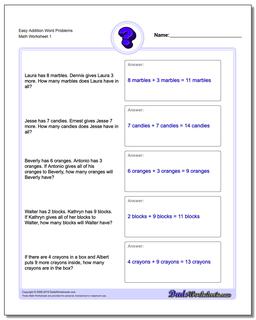
Subtraction Word Problems
These worksheets include simple word problems for subtraction with smaller quantities. Watch for words like difference and remaining.
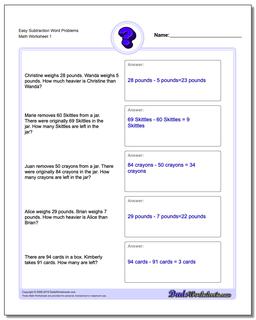
Mixed Addition and Subtraction Word Problems
8 word problems worksheets.
This set of worksheets includes a mix of addition and subtraction word problems. Students are required to figured out which operation to apply given the problem context.
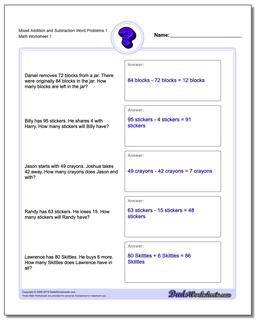
Multiplication Word Problems
This is the first set of word problem worksheets the introduces multiplication. These worksheets include only multiplication story problems; see worksheets in the following sections for mixed operations.
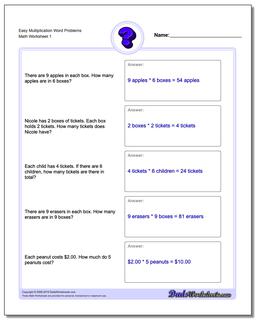
Division Word Problems
These division story problems deal with only whole divisions (quotients without remainders.) This is a great first step to recognizing the keywords that signal you are solving a division word problem.
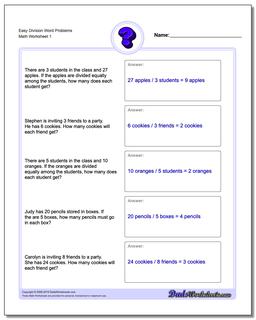
Girl Scout Cookie Division
If you've been working as Troop Cookie Mom (or Dad!) you'll know what kind of math we've been practicing... These worksheets are primarily division word problems that introduce remainders. Pull your tagalongs or your thin mints out of the box and figure out how many remainders you'll be allowed to eat!
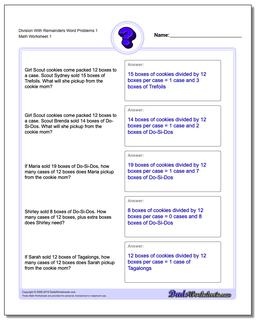
Division With Remainders Word Problems
24 word problems worksheets.
The worksheets in this section are made up of story problems using division and involving remainders. These are similar to the Girl Scout problems in the prior section, but with different units.
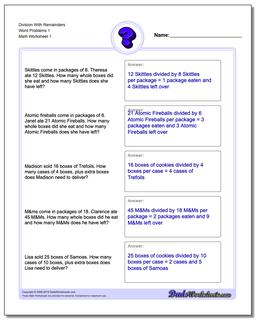
Mixed Multiplication and Division Word Problems
This worksheets combine basic multiplication and division word problems. The division problems do not include remainders. These worksheets require the students to differentiate between the phrasing of a story problem that requires multiplication versus one that requires division to reach the answer.
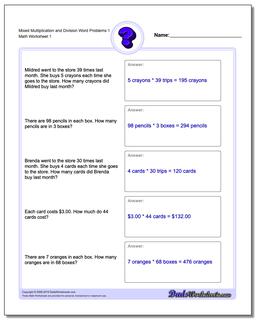
Mixed Operation Word Problems
The whole enchilada! These workshes mix addition, subtraction, multiplication and division word problems. These worksheets will test a students ability to choose the correct operation based on the story problem text.
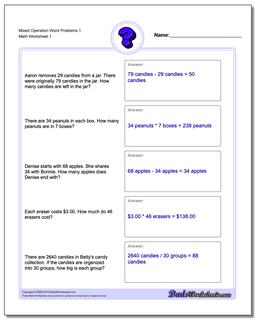
Extra Facts Addition Word Problems
One way to make a word problem slightly more complex is to include extra (but unused) information in the problem text. These worksheets have addition word problems with extra unused facts in the problem.
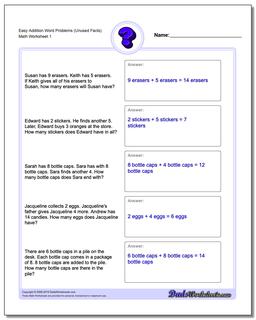
Extra Facts Subtraction Word Problems
Word problem worksheets for subtraction with extra unused facts in each problem. The worksheets start out with subtraction problems with smaller values and progress through more difficult problems.
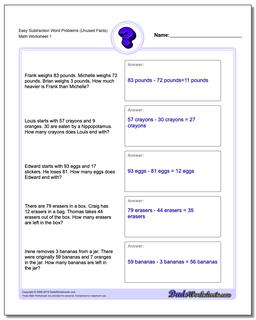
Extra Facts Addition and Subtraction Word Problems
Mixed operation addition and subtraction word problem worksheets with extra unused facts in the problems.
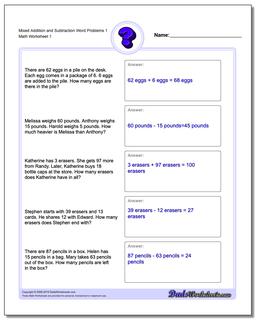
Extra Facts Multiplication Word Problems
Word problems for multiplication with extra unused facts in the problem. The worksheets in this set start out with multiplication problems with smaller values and progress through more difficult problems.
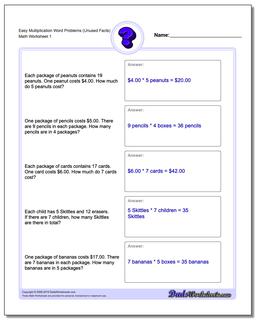
Extra Facts Division Word Problems
The worksheets in this section include math word problems for division with extra unused facts in the problem. The quotients in these division problems do not include remainders.
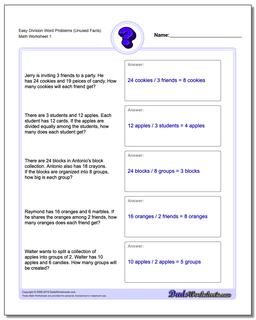
Extra Facts Multiplication and Division Word Problems
16 word problems worksheets.
This is a collection of worksheets with mixed multiplication and division word problems and extra unused facts in the problem. The quotients in these division problems do not include remainders.
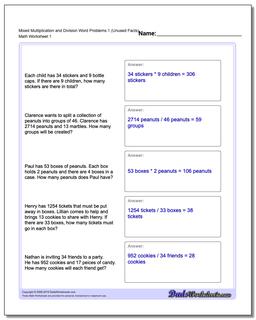
Travel Time Word Problems (Customary)
28 word problems worksheets.
These story problems deal with travel time, including determining the travel distance, travel time and speed using miles (customary units). This is a very common class of word problem and specific practice with these worksheets will prepare students when they encounter similar problems on standardized tests.
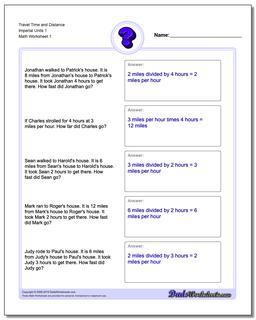
Travel Time Word Problems (Metric)
Wondering when the train arrives? These story problems deal with travel time, including determining the travel distance, travel time and speed using kilometers (metric units).
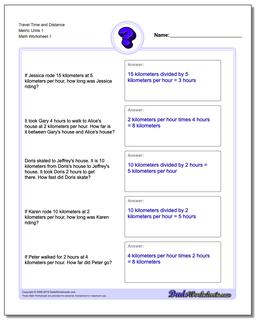
Tricks for Solving Word Problems
The math worksheets on this section of the site deal with simple word problems appropriate for primary grades. The simple addition word problems can be introduced very early, in first or second grade depending on student aptitude. Follow those worksheets up with the subtraction word problems once subtraction concept are covered, and then proceed with multiplication and division word problems in the same fashion.
Word problems are often a source of anxiety for students because we tend to introduce math operations in the abstract. Students struggle to apply even elementary operations to word problems unless they have been taught consistently to think about math operations in their day to day routines. Talking with kids regularly about 'how many more do you need' or 'how many do you have left over' or other seemingly simple questions when asked regularly can build that basic number sense that helps enormously when word problems and applied math start to show up.
There are many tricks for solving word problems that can bridge the gap, and they can be helpful tools if students are either struggling with where to start with a problem or just need a way to check their thinking on a particular problem.
Make sure your student reads the entire problem first. It is very easy to start reading a word problem and think after the first sentence or two that 'I know what they're asking for...' and then have the problem take an entirely different turn. Overcoming this early solution bias can be difficult, and it is much better to develop the habit of making a complete pass over the problem before deciding on a path to the solution.
There are particular words that seem to show up in word problems for different operations that can tip you off to what might be the correct operation to apply. These key words aren't a sure-fire way to know what to do with a problem, but they can be a useful starting point.
For example, phrases like 'combined,' 'total,' 'together' or 'sum' are very often signals that the problem is going to involve addition.
Subtraction word problems very often use words such as 'difference,' 'less,' or 'decrease' in their wording. Word problems for younger kids will also use verbs like 'gave' or 'shared' as a stand-in for subtraction.
The key phrases to watch out for multiplication word problems include obvious ones like 'times' and 'product,' but also be on the look out for 'for each' and 'every.'
Learning when to apply division in a word problem can be tricky, especially for younger kids who haven't fully developed a concept of what division can be used for... But that's exactly why division word problems can be so useful! If you see words like 'per' or 'among' in the word problem text, your division radar should be sounding off loud and clear. Pay attention to 'shared among' and make sure students don't confuse this phrasing with a subtraction word problem. That's a clear example of when paying attention to the language is very important.
Draw a Picture!
One key bit of advice, especially for basic word problems, is to encourage students to draw a picture. Most early grade school word problems are basic counting exercises, where you're dealing with quantities or sets that are fairly small. If students can draw a picture of the problem (even using simple representations like squares or circles for the units discussed in the problem), then it can help them visualize exactly what's occurring.
Another useful visualization strategy is to use manipulatives. Paper clips, checkers or other handy objects can stand in place of the problem's subject, and this provides an opportunity to work up other simple examples with different numbers.

Copyright 2008-2024 DadsWorksheets, LLC
Math Word Problems
Welcome to the math word problems worksheets page at Math-Drills.com! On this page, you will find Math word and story problems worksheets with single- and multi-step solutions on a variety of math topics including addition, multiplication, subtraction, division and other math topics. It is usually a good idea to ensure students already have a strategy or two in place to complete the math operations involved in a particular question. For example, students may need a way to figure out what 7 × 8 is or have previously memorized the answer before you give them a word problem that involves finding the answer to 7 × 8.
There are a number of strategies used in solving math word problems; if you don't have a favorite, try the Math-Drills.com problem-solving strategy:
- Question : Understand what the question is asking. What operation or operations do you need to use to solve this question? Ask for help to understand the question if you can't do it on your own.
- Estimate : Use an estimation strategy, so you can check your answer for reasonableness in the evaluate step. Try underestimating and overestimating, so you know what range the answer is supposed to be in. Be flexible in rounding numbers if it will make your estimate easier.
- Strategize : Choose a strategy to solve the problem. Will you use mental math, manipulatives, or pencil and paper? Use a strategy that works for you. Save the calculator until the evaluate stage.
- Calculate : Use your strategy to solve the problem.
- Evaluate : Compare your answer to your estimate. If you under and overestimated, is the answer in the correct range. If you rounded up or down, does the answer make sense (e.g. is it a little less or a little more than the estimate). Also check with a calculator.
Most Popular Math Word Problems this Week
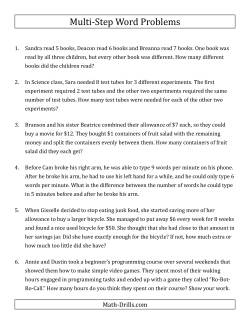
Arithmetic Word Problems
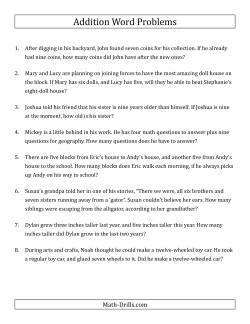
- Addition Word Problems One-Step Addition Word Problems Using Single-Digit Numbers One-Step Addition Word Problems Using Two-Digit Numbers
- Subtraction Word Problems Subtraction Facts Word Problems With Differences from 5 to 12
- Multiplication Word Problems One-Step Multiplication Word Problems up to 10 × 10
- Division Word Problems Division Facts Word Problems with Quotients from 5 to 12
- Multi-Step Word Problems Easy Multi-Step Word Problems
Copyright © 2005-2024 Math-Drills.com You may use the math worksheets on this website according to our Terms of Use to help students learn math.

How do you solve word problems in math?
Master word problems with eight simple steps from a math tutor!

Author Amber Watkins
Published April 2024

- Key takeaways
- Students who struggle with reading, tend to struggle with understanding and solving word problems. So the best way to solve word problems in math is to become a better reader!
- Mastery of word problems relies on your child’s knowledge of keywords for word problems in math and knowing what to do with them.
- There are 8 simple steps each child can use to solve word problems- let’s go over these together.
Table of contents
- How to solve word problems
Lesson credits
As a tutor who has seen countless math worksheets in almost every grade – I’ll tell you this: every child is going to encounter word problems in math. The key to mastery lies in how you solve them! So then, how do you solve word problems in math?
In this guide, I’ll share eight steps to solving word problems in math.
How to solve word problems in math in 8 steps
Step 1: read the word problem aloud.
For a child to understand a word problem, it needs to be read with accuracy and fluency! That is why, when I tutor children with word problems, I always emphasize the importance of reading properly.
Mastering step 1 looks like this:
- Allow your child to read the word problem aloud to you.
- Don’t let your child skip over or mispronounce any words.
- If necessary, model how to read the word problem, then allow your child to read it again. Only after the word problem is read accurately, should you move on to step 2.
Step 2: Highlight the keywords in the word problem
The keywords for word problems in math indicate what math action should be taken. Teach your child to highlight or underline the keywords in every word problem.
Here are some of the most common keywords in math word problems:
- Subtraction words – less than, minus, take away
- Addition words – more than, altogether, plus, perimeter
- Multiplication words – Each, per person, per item, times, area
- Division words – divided by, into
- Total words – in all, total, altogether
Let’s practice. Read the following word problem with your child and help them highlight or underline the main keyword, then decide which math action should be taken.
Michael has ten baseball cards. James has four baseball cards less than Michael. How many total baseball cards does James have?
The words “less than” are the keywords and they tell us to use subtraction .
Step 3: Make math symbols above keywords to decode the word problem
As I help students with word problems, I write math symbols and numbers above the keywords. This helps them to understand what the word problem is asking.
Let’s practice. Observe what I write over the keywords in the following word problem and think about how you would create a math sentence using them:

Step 4: Create a math sentence to represent the word problem
Using the previous example, let’s write a math sentence. Looking at the math symbols and numbers written above the word problem, our math sentence should be: 10 – 5 = 5 !
Each time you practice a word problem with your child, highlight keywords and write the math symbols above them. Then have your child create a math sentence to solve.
Step 5: Draw a picture to help illustrate the word problem
Pictures can be very helpful for problems that are more difficult to understand. They also are extremely helpful when the word problem involves calculating time , comparing fractions , or measurements .
Step 6: Always show your work
Help your child get into the habit of always showing their work. As a tutor, I’ve found many reasons why having students show their work is helpful:
- By showing their work, they are writing the math steps repeatedly, which aids in memory
- If they make any mistakes they can track where they happened
- Their teacher can assess how much they understand by reviewing their work
- They can participate in class discussions about their work
Step 7: When solving word problems, make sure there is always a word in your answer!
If the word problem asks: How many peaches did Lisa buy? Your child’s answer should be: Lisa bought 10 peaches .
If the word problem asks: How far did Kyle run? Your child’s answer should be: Kyle ran 20 miles .
So how do you solve a word problem in math?
Together we reviewed the eight simple steps to solve word problems. These steps included identifying keywords for word problems in math, drawing pictures, and learning to explain our answers.
Is your child ready to put these new skills to the test? Check out the best math app for some fun math word problem practice.

Parents, sign up for a DoodleMath subscription and see your child become a math wizard!

Amber Watkins
Amber is an education specialist with a degree in Early Childhood Education. She has over 12 years of experience teaching and tutoring elementary through college level math. "Knowing that my work in math education makes such an impact leaves me with an indescribable feeling of pride and joy!"
What we offer
Quick links
All rights reserved.

Are you a parent, teacher or student?
Get started for free!
Maths information pack
We ask for your contact info so we can send our info pack directly to your inbox for your convenience, exam prep information pack, case studies information pack.
Book a chat with our team

I’m new to Doodle

My school is already using Doodle

Information pack
We ask for your contact info so that our education consultants can get in touch with you and let you know a bit more about doodle., student login, which programme would you like to use.
DoodleMaths
DoodleTables
DoodleEnglish
DoodleSpell
If you’d like to use Doodle’s browser version, please visit this page on a desktop.
To log in to Doodle on this device, you can do so through our apps. You can find out how to download them here:
- Grades 6-12
- School Leaders
FREE 2024-25 Printable Teacher Calendar! 🗓️
14 Effective Ways to Help Your Students Conquer Math Word Problems
If a train leaving Minneapolis is traveling at 87 miles an hour…
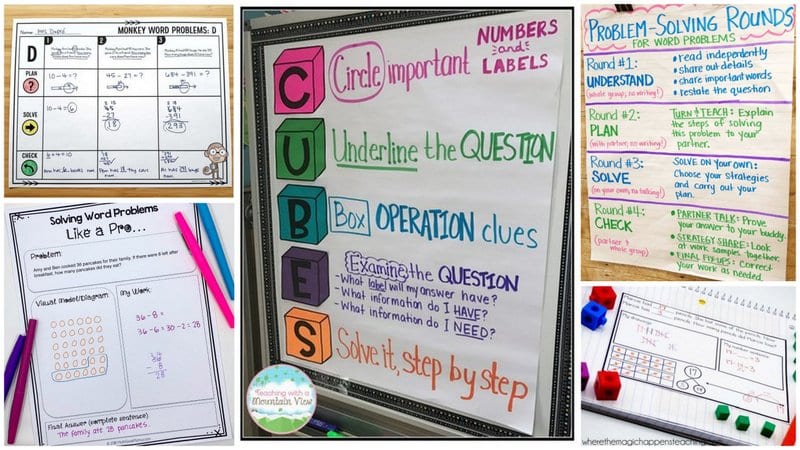
Word problems can be tricky for a lot of students, but they’re incredibly important to master. After all, in the real world, most math is in the form of word problems. “If one gallon of paint covers 400 square feet, and my wall measures 34 feet by 8 feet, how many gallons do I need?” “This sweater costs $135, but it’s on sale for 35% off. So how much is that?” Here are the best teacher-tested ideas for helping kids get a handle on these problems.
1. Solve word problems regularly
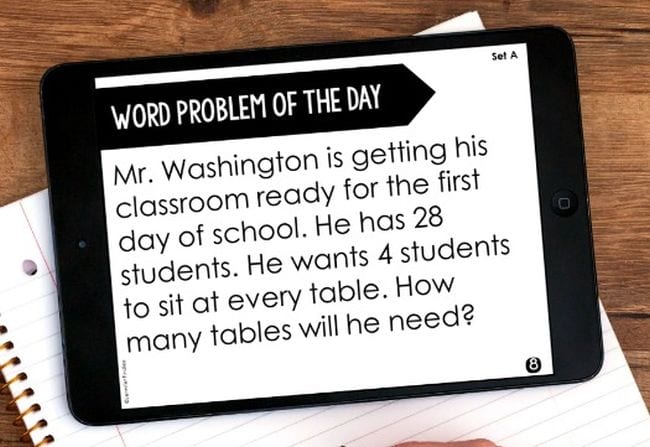
This might be the most important tip of all. Word problems should be part of everyday math practice, especially for older kids. Whenever possible, use word problems every time you teach a new math skill. Even better: give students a daily word problem to solve so they’ll get comfortable with the process.
Learn more: Teaching With Jennifer Findlay
2. Teach problem-solving routines
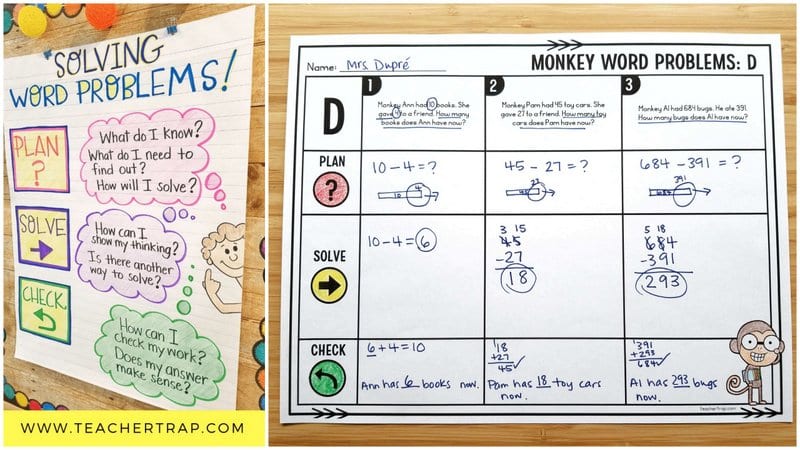
There are a LOT of strategies out there for teaching kids how to solve word problems (keep reading to see some terrific examples). The important thing to remember is that what works for one student may not work for another. So introduce a basic routine like Plan-Solve-Check that every kid can use every time. You can expand on the Plan and Solve steps in a variety of ways, but this basic 3-step process ensures kids slow down and take their time.
Learn more: Word Problems Made Easy
[contextly_auto_sidebar]
3. Visualize or model the problem
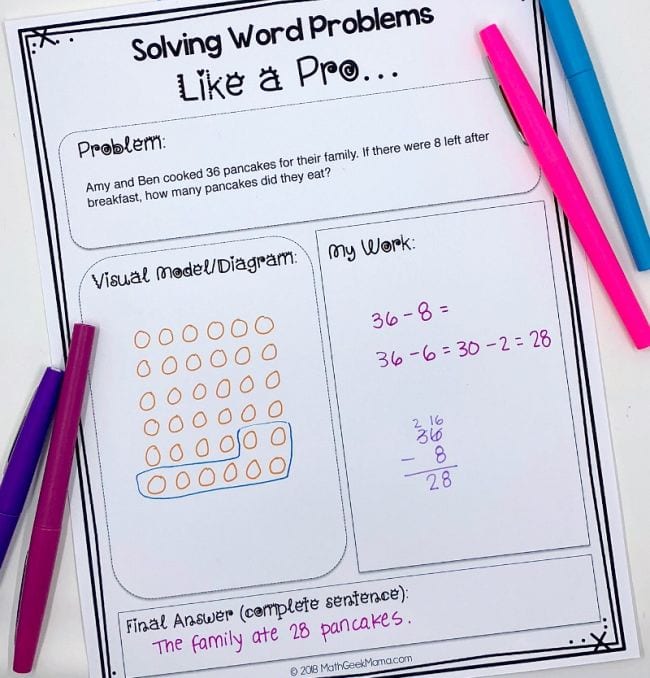
Encourage students to think of word problems as an actual story or scenario. Try acting the problem out if possible, and draw pictures, diagrams, or models. Learn more about this method and get free printable templates at the link.
Learn more: Math Geek Mama
4. Make sure they identify the actual question
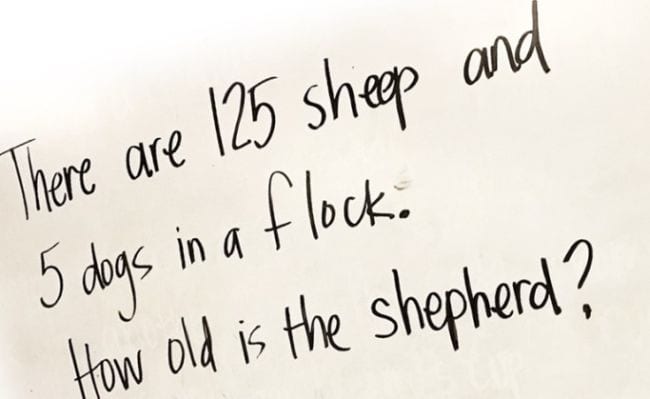
Educator Robert Kaplinsky asked 32 eighth grade students to answer this nonsensical word problem. Only 25% of them realized they didn’t have the right information to answer the actual question; the other 75% gave a variety of numerical answers that involved adding, subtracting, or dividing the two numbers. That tells us kids really need to be trained to identify the actual question being asked before they proceed.
Learn more: Robert Kaplinsky
5. Remove the numbers
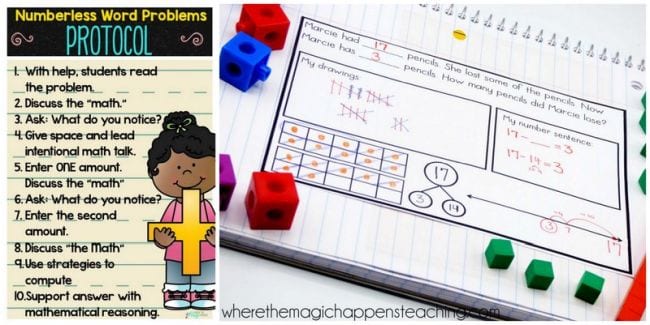
It seems counterintuitive … math without numbers? But this word problem strategy really forces kids to slow down and examine the problem itself, without focusing on numbers at first. If the numbers were removed from the sheep/shepherd problem above, students would have no choice but to slow down and read more carefully, rather than plowing ahead without thinking.
Learn more: Where the Magic Happens Teaching
6. Try the CUBES method
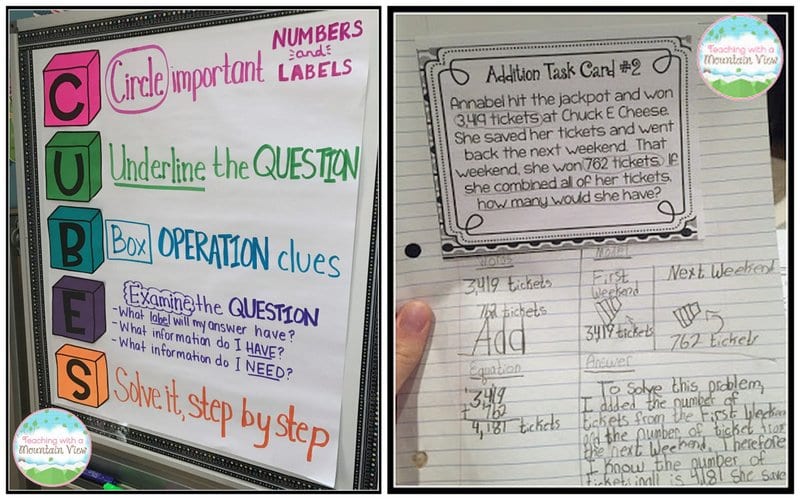
This is a tried-and-true method for teaching word problems, and it’s really effective for kids who are prone to working too fast and missing details. By taking the time to circle, box, and underline important information, students are more likely to find the correct answer to the question actually being asked.
Learn more: Teaching With a Mountain View
7. Show word problems the LOVE
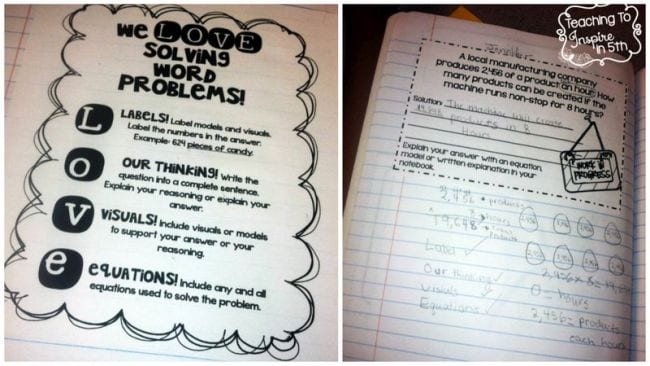
Here’s another fun acronym for tackling word problems: LOVE. Using this method, kids Label numbers and other key info, then explain Our thinking by writing the equation as a sentence. They use Visuals or models to help plan and list any and all Equations they’ll use.
8. Consider teaching word problem key words
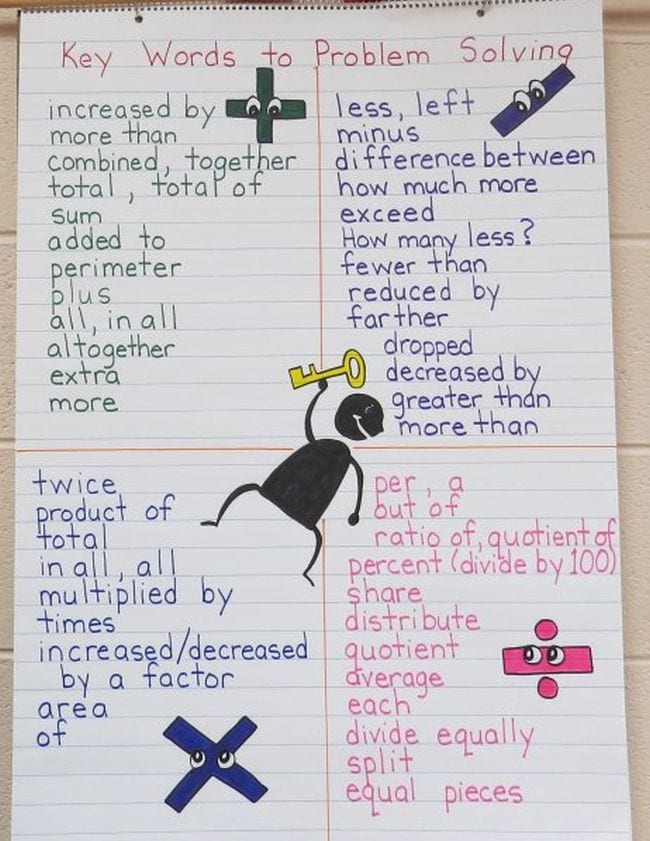
This is one of those methods that some teachers love and others hate. Those who like it feel it offers kids a simple tool for making sense of words and how they relate to math. Others feel it’s outdated, and prefer to teach word problems using context and situations instead (see below). You might just consider this one more trick to keep in your toolbox for students who need it.
Learn more: Book Units Teacher
9. Determine the operation for the situation
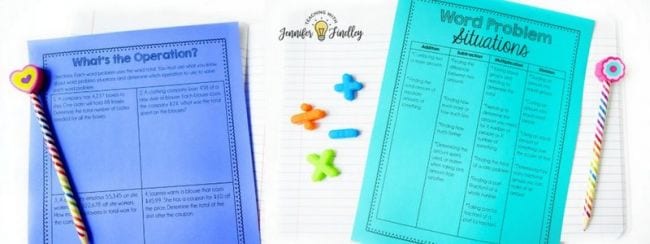
Instead of (or in addition to) key words, have kids really analyze the situation presented to determine the right operation(s) to use. Some key words, like “total,” can be pretty vague. It’s worth taking the time to dig deeper into what the problem is really asking. Get a free printable chart and learn how to use this method at the link.
Learn more: Solving Word Problems With Jennifer Findlay
10. Differentiate word problems to build skills
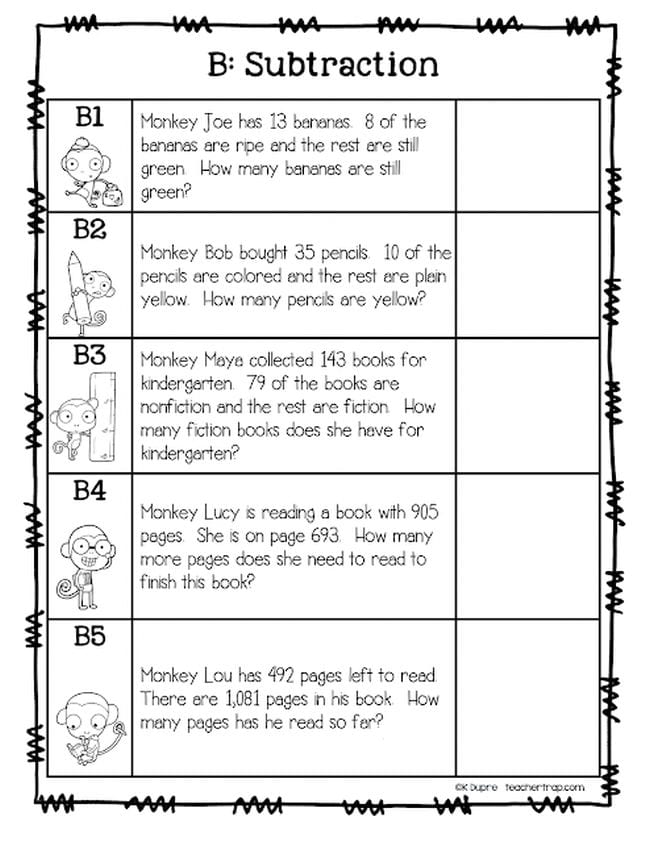
Sometimes students get so distracted by numbers that look big or scary that they give up right off the bat. For those cases, try working your way up to the skill at hand. For instance, instead of jumping right to subtracting 4 digit numbers, make the numbers smaller to start. Each successive problem can be a little more difficult, but kids will see they can use the same method regardless of the numbers themselves.
Learn more: Differentiating Math
11. Ensure they can justify their answers
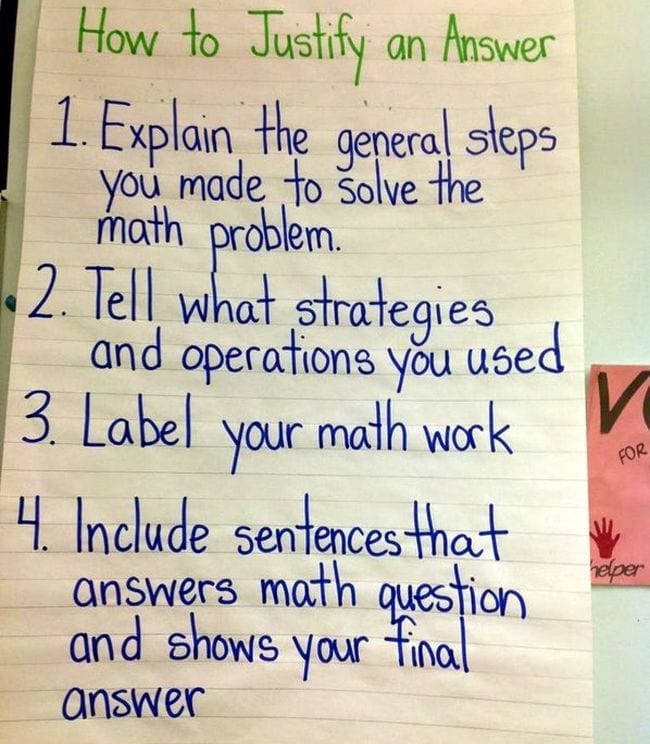
One of the quickest ways to find mistakes is to look closely at your answer and ensure it makes sense. If students can explain how they came to their conclusion, they’re much more likely to get the answer right. That’s why teachers have been asking students to “show their work” for decades now.
Learn more: Madly Learning
12. Write the answer in a sentence
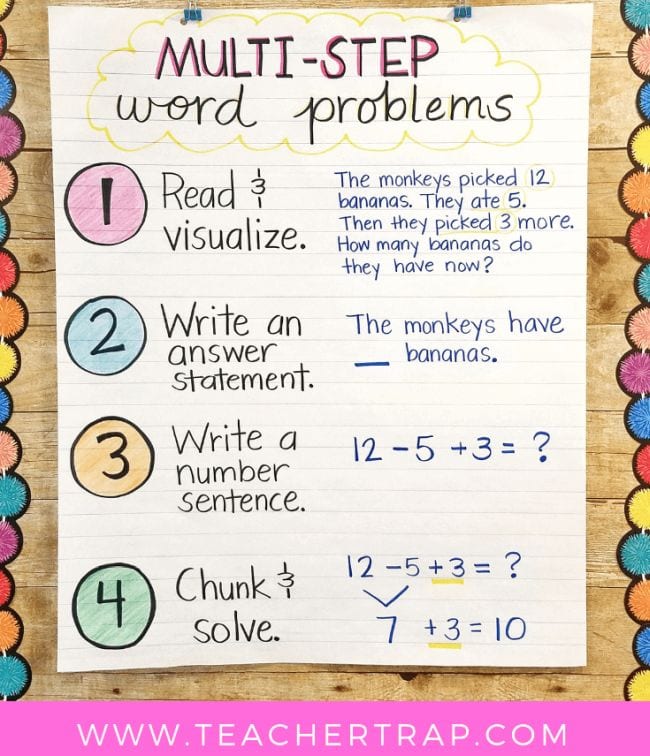
When you think about it, this one makes so much sense. Word problems are presented in complete sentences, so the answers should be too. This helps students make certain they’re actually answering the question being asked… part of justifying their answer.
Learn more: Multi-Step Word Problems
13. Add rigor to your word problems

A smart way to help kids conquer word problems is to, well… give them better problems to conquer. A rich math word problem is accessible and feels real to students, like something that matters. It should allow for different ways to solve it and be open for discussion. A series of problems should be varied, using different operations and situations when possible, and even include multiple steps. Visit both of the links below for excellent tips on adding rigor to your math word problems.
Learn more: The Routty Math Teacher and Alyssa Teaches
14. Use a problem-solving rounds activity.
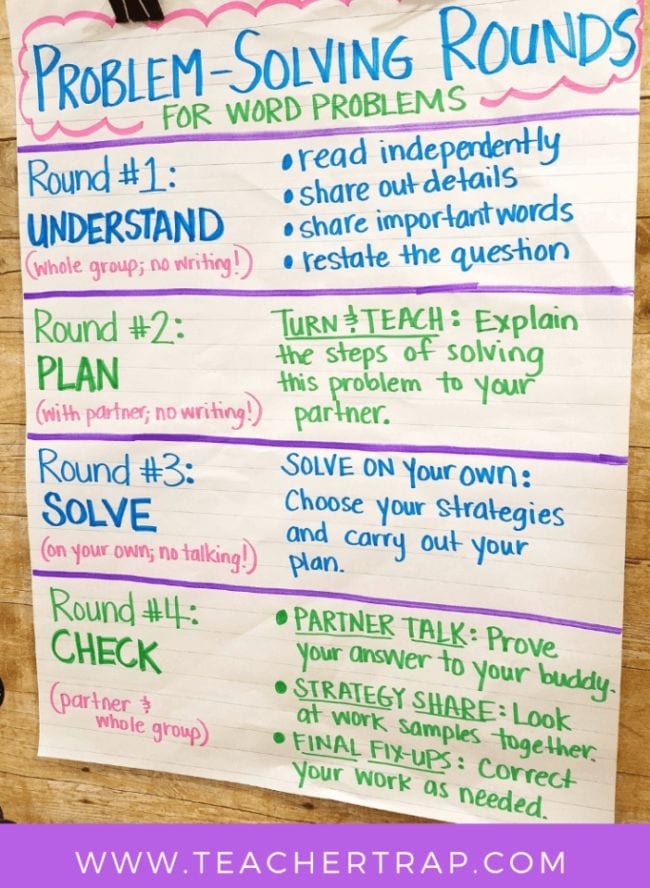
Put all those word problem strategies and skills together with this whole-class activity. Start by reading the problem as a group and sharing important information. Then, have students work with a partner to plan how they’ll solve it. In round three, kids use those plans to solve the problem individually. Finally, they share their answer and methods with their partner and the class. Be sure to recognize and respect all problem-solving strategies that lead to the correct answer.
Learn more: Teacher Trap
Like these word problem tips and tricks? Learn more about Why It’s Important to Honor All Math Strategies .
Plus, 60+ Awesome Websites For Teaching and Learning Math .
You Might Also Like

8 Creative Ways to Use Sketchnotes in Your Classroom
It's like doodling with purpose. Continue Reading
Copyright © 2024. All rights reserved. 5335 Gate Parkway, Jacksonville, FL 32256
MAKE WAVES WITH THIS FREE WEEKLONG VOCABULARY UNIT!

Strategies for Solving Word Problems – Math
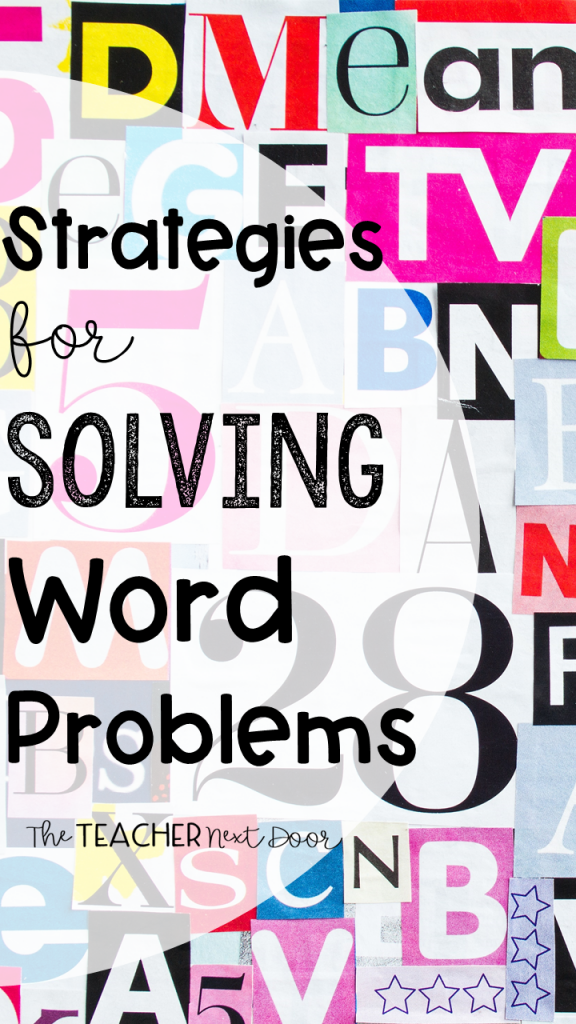
It’s one thing to solve a math equation when all of the numbers are given to you but with word problems, when you start adding reading to the mix, that’s when it gets especially tricky.
The simple addition of those words ramps up the difficulty (and sometimes the math anxiety) by about 100!
How can you help your students become confident word problem solvers? By teaching your students to solve word problems in a step by step, organized way, you will give them the tools they need to solve word problems in a much more effective way.
Here are the seven strategies I use to help students solve word problems.
1. read the entire word problem.
Before students look for keywords and try to figure out what to do, they need to slow down a bit and read the whole word problem once (and even better, twice). This helps kids get the bigger picture to be able to understand it a little better too.
2. Think About the Word Problem
Students need to ask themselves three questions every time they are faced with a word problem. These questions will help them to set up a plan for solving the problem.
Here are the questions:
A. what exactly is the question.
What is the problem asking? Often times, curriculum writers include extra information in the problem for seemingly no good reason, except maybe to train kids to ignore that extraneous information (grrrr!). Students need to be able to stay focused, ignore those extra details, and find out what the real question is in a particular problem.
B. What do I need in order to find the answer?
Students need to narrow it down, even more, to figure out what is needed to solve the problem, whether it’s adding, subtracting, multiplying, dividing, or some combination of those. They’ll need a general idea of which information will be used (or not used) and what they’ll be doing.
This is where key words become very helpful. When students learn to recognize that certain words mean to add (like in all, altogether, combined ), while others mean to subtract, multiply, or to divide, it helps them decide how to proceed a little better
Here’s a Key Words Chart I like to use for teaching word problems. The handout could be copied at a smaller size and glued into interactive math notebooks. It could be placed in math folders or in binders under the math section if your students use binders.
One year I made huge math signs (addition, subtraction, multiplication, and divide symbols) and wrote the keywords around the symbols. These served as a permanent reminder of keywords for word problems in the classroom.
If you’d like to download this FREE Key Words handout, click here:
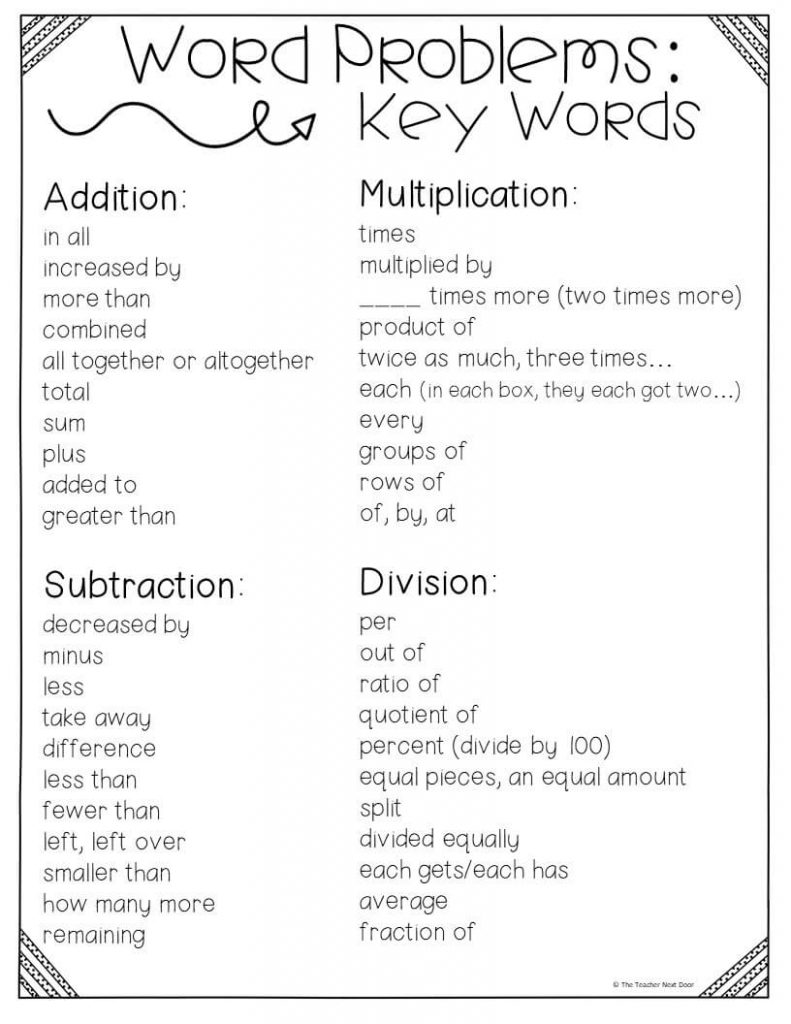
C. What information do I already have?
This is where students will focus in on the numbers which will be used to solve the problem.
3. Write on the Word Problem
This step reinforces the thinking which took place in step number two. Students use a pencil or colored pencils to notate information on worksheets (not books of course, unless they’re consumable). There are lots of ways to do this, but here’s what I like to do:
- Circle any numbers you’ll use.
- Lightly cross out any information you don’t need.
- Underline the phrase or sentence which tells exactly what you’ll need to find.
4. Draw a Simple Picture and Label It
Drawing pictures using simple shapes like squares, circles, and rectangles help students visualize problems. Adding numbers or names as labels help too.
For example, if the word problem says that there were five boxes and each box had 4 apples in it, kids can draw five squares with the number four in each square. Instantly, kids can see the answer so much more easily!
5. Estimate the Answer Before Solving
Having a general idea of a ballpark answer for the problem lets students know if their actual answer is reasonable or not. This quick, rough estimate is a good math habit to get into. It helps students really think about their answer’s accuracy when the problem is finally solved.
6. Check Your Work When Done
This strategy goes along with the fifth strategy. One of the phrases I constantly use during math time is, Is your answer reasonable ? I want students to do more than to be number crunchers but to really think about what those numbers mean.
Also, when students get into the habit of checking work, they are more apt to catch careless mistakes, which are often the root of incorrect answers.
7. Practice Word Problems Often
Just like it takes practice to learn to play the clarinet, to dribble a ball in soccer, and to draw realistically, it takes practice to become a master word problem solver.
When students practice word problems, often several things happen. Word problems become less scary (no, really).
They start to notice similarities in types of problems and are able to more quickly understand how to solve them. They will gain confidence even when dealing with new types of word problems, knowing that they have successfully solved many word problems in the past.
If you’re looking for some word problem task cards, I have quite a few of them for 3rd – 5th graders.
This 3rd grade math task cards bundle has word problems in almost every one of its 30 task card sets..
There are also specific sets that are dedicated to word problems and two-step word problems too. I love these because there’s a task card set for every standard.
CLICK HERE to take a look at 3rd grade:
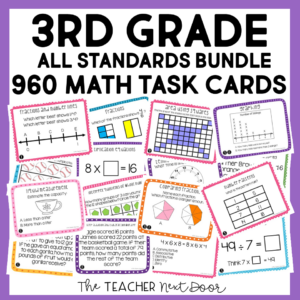
This 4th Grade Math Task Cards Bundle also has lots of word problems in almost every single of its 30 task card sets. These cards are perfect for centers, whole class, and for one on one.
CLICK HERE to see 4th grade:
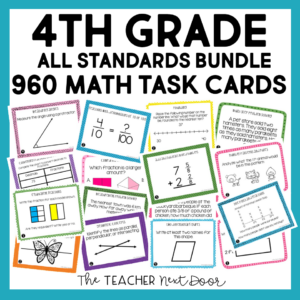
This 5th Grade Math Task Cards Bundle is also loaded with word problems to give your students focused practice.
CLICK HERE to take a look at 5th grade:
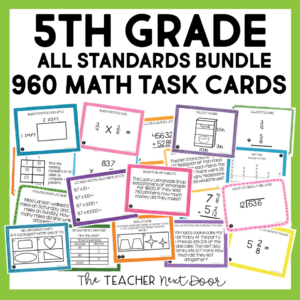
Want to try a FREE set of math task cards to see what you think?
3rd Grade: Rounding Whole Numbers Task Cards
4th Grade: Convert Fractions and Decimals Task Cards
5th Grade: Read, Write, and Compare Decimals Task Cards
Thanks so much for stopping by!

- Read more about: Math
You might also like...
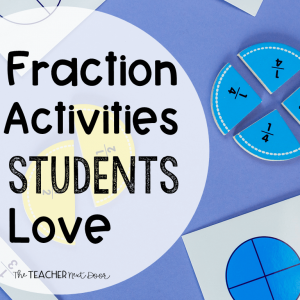
Fraction Activities Students Love – Math
Fractions can be tough! While it takes time and repeated exposure with fractions for students to have a real understanding of them, there are lots
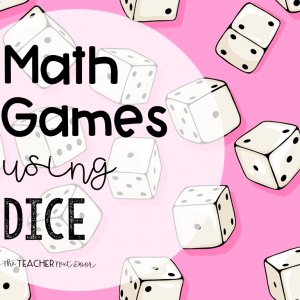
Math Games Using Dice
Games are an important part of math class, in my opinion. Not only are kids able to practice the skills that we have been focusing
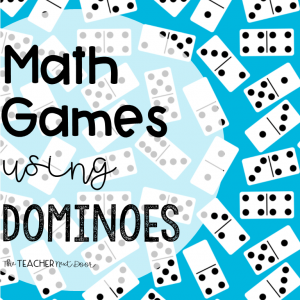
Math Games Using Dominoes
Math games have always been part of our math time. I love the fact that any time I introduce a math game, I know I’ll
Hi, I’m Jenn, CEO and owner of The Teacher Next Door!
I know that you strive to be an effective upper elementary teacher while maintaining a healthy work-life balance.
In order to do that, you need resources that are impactful, yet simple .
The problem is that most resources and curriculums out there are far from simple. The pages upon pages of daily lesson plans are just plain overwhelming .
At TTND, we believe teachers should be living their lives outside of the classroom, and not spend hours lesson planning and searching for resources.
We understand that now, more than ever, teachers need space to be themselves which is why we create and support teachers with timesaving tips and standards-aligned resources.
Want access to TTND's Free Resource Library? Sign up for our newsletter and we'll email you the exclusive password!
Trending posts.

SEARCH BY TOPIC
- Classroom Ideas
- Holidays and Seasonal
- Mentor Texts
- Reading Block
- Uncategorized
- Writing & Grammar
POPULAR RESOURCES

Facebook Group
Teachers Pay Teachers
Free Resource Library
💌 Contact Us
Disclosures
Privacy Policy
Refund Policy
Purchase Orders
Your Downloads
Reward Points
© The Teacher Next Door, LLC. All rights reserved.

* Please note: If your school has strong email filters, you may wish to use your personal email to ensure access.
- Inspiration
Word problems
Here is a list of all of the skills that cover word problems! These skills are organized by grade, and you can move your mouse over any skill name to preview the skill. To start practicing, just click on any link. IXL will track your score, and the questions will automatically increase in difficulty as you improve!
Here is a list of all of the skills that cover word problems! To start practicing, just click on any link.
Pre-K skills
- V.8 Addition word problems with pictures - sums up to 5
- W.8 Addition word problems with pictures - sums up to 10
- X.7 Subtraction word problems with pictures - numbers up to 5
- Y.7 Subtraction word problems with pictures - numbers up to 10
Kindergarten skills
- Q.1 Build cube trains to solve addition word problems - sums up to 5
- Q.2 Addition word problems with pictures - sums up to 5
- Q.3 Write addition sentences for word problems with pictures - sums up to 5
- Q.4 Addition word problems - sums up to 5
- Q.5 Model and write addition sentences for word problems - sums up to 5
- U.1 Build cube trains to solve addition word problems - sums up to 10
- U.2 Addition word problems with pictures - sums up to 10
- U.3 Write addition sentences for word problems with pictures - sums up to 10
- U.4 Addition word problems - sums up to 10
- U.5 Model and write addition sentences for word problems - sums up to 10
- V.4 Subtraction sentences up to 5 - what does the cube train show?
- X.1 Subtraction word problems with pictures - numbers up to 5
- X.2 Write subtraction sentences for word problems with pictures - up to 5
- X.3 Use cube trains to solve subtraction word problems - up to 5
- X.4 Subtraction word problems - numbers up to 5
- X.5 Model and write subtraction sentences for word problems - up to 5
- Y.4 Subtraction sentences up to 10 - what does the cube train show?
- AA.1 Subtraction word problems with pictures - numbers up to 10
- AA.2 Write subtraction sentences for word problems with pictures - up to 10
- AA.3 Use cube trains to solve subtraction word problems - up to 10
- AA.4 Subtraction word problems - numbers up to 10
- AA.5 Model and write subtraction sentences for word problems - up to 10
- CC.1 Addition and subtraction word problems with pictures
- CC.2 Use cube trains to solve addition and subtraction word problems - up to 10
- CC.3 Addition and subtraction word problems
- CC.4 Model and write addition and subtraction sentences for word problems
First-grade skills
- C.6 Skip-counting patterns - with tables
- H.1 Addition word problems with pictures - sums up to 10
- H.2 Write addition sentences for word problems with pictures - sums up to 10
- H.3 Build cube trains to solve addition word problems - sums up to 10
- H.4 Addition word problems - sums up to 10
- H.5 Model and write addition sentences for word problems - sums up to 10
- H.6 Addition sentences for word problems - sums up to 10
- I.5 Subtraction sentences up to 10: what does the cube train show?
- L.1 Subtraction word problems with pictures - up to 10
- L.2 Write subtraction sentences for word problems with pictures - up to 10
- L.3 Use cube trains to solve subtraction word problems - up to 10
- L.4 Subtraction word problems - up to 10
- L.5 Model and write subtraction sentences for word problems - up to 10
- L. New! Subtraction sentences for "take apart" word problems - up to 10
- L.6 Subtraction sentences for word problems - up to 10
- N.1 Comparison word problems up to 10: how many more?
- N. New! Subtraction sentences for comparison word problems up to 10: how many more?
- N.2 Comparison word problems up to 10: how many fewer?
- N. New! Subtraction sentences for comparison word problems up to 10: how many fewer?
- N.3 Comparison word problems up to 10: how many more or fewer?
- N. New! Subtraction sentences for comparison word problems up to 10: how many more or fewer?
- N.4 Comparison word problems up to 10: what is the larger amount?
- N.5 Comparison word problems up to 10: what is the smaller amount?
- N.6 Comparison word problems up to 10
- O. New! Addition and subtraction word problems with pictures - up to 10
- O. New! Use cube trains to solve addition and subtraction word problems - up to 10
- O.1 Word problems with unknown sums and differences - up to 10
- O. New! Addition and subtraction sentences for word problems - up to 10
- O.2 Word problems with change unknown - up to 10
- O.3 Word problems with start unknown - up to 10
- O.4 Word problems with one addend unknown - up to 10
- O.5 Word problems with both addends unknown - up to 10
- O.6 Word problems involving addition and subtraction - up to 10
- O. New! Match word problems to addition and subtraction sentences - up to 10
- R. New! Addition word problems with models - sums up to 20
- R.1 Addition word problems - sums up to 20
- R.2 Addition sentences for word problems - sums up to 20
- R.3 Add three numbers - word problems
- U.1 Subtraction word problems - up to 20
- U.2 Subtraction sentences for word problems - up to 20
- W.1 Comparison word problems up to 20: how many more or fewer?
- W.2 Comparison word problems up to 20: what is the larger amount?
- W.3 Comparison word problems up to 20: what is the smaller amount?
- W. New! Comparison word problems up to 20: part 1
- W.4 Comparison word problems up to 20: part 2
- X. New! Match word problems to addition and subtraction sentences - up to 20
- X. New! Word problems with one addend unknown - up to 20
- X. New! Word problems with both addends unknown - up to 20
- X. New! Use models to solve word problems involving addition and subtraction - up to 20
- X.1 Word problems involving addition and subtraction - up to 20
- X.2 Addition and subtraction sentences for word problems - up to 20
- BB.4 Compare numbers up to 100: word problems
- DD.13 Addition word problems - one-digit plus two-digit numbers
- DD.14 Addition sentences for word problems - one-digit plus two-digit numbers
- EE.10 Customary units of length: word problems
- EE.12 Metric units of length: word problems
- FF.7 Time and clocks: word problems
- HH.8 Money - word problems
Second-grade skills
- B.5 Greatest and least - word problems - up to 100
- B.6 Greatest and least - word problems - up to 1,000
- C.6 Skip-counting stories
- C.10 Skip-counting puzzles
- G.3 Addition word problems - sums to 20
- G.4 Addition sentences for word problems - sums to 20
- G.9 Addition word problems - three one-digit numbers
- G.11 Addition word problems - four or more one-digit numbers
- I.3 Subtraction word problems - up to 18
- I.4 Subtraction sentences for word problems - up to 18
- K.1 Comparison word problems - up to 20
- K. New! Use models to solve addition and subtraction word problems - up to 20
- K.2 Addition and subtraction word problems - up to 20
- K. New! Match word problems to addition and subtraction sentences - up to 20
- K.3 Two-step addition and subtraction word problems - up to 20
- K.4 Solve word problems using guess-and-check - up to 20
- L.16 Guess the number
- N.7 Addition word problems - up to two digits
- N.15 Addition word problems - three numbers up to two digits each
- N.18 Addition word problems - four numbers up to two digits each
- P.10 Subtraction word problems - up to two digits
- R.1 Addition and subtraction word problems - up to 100
- R.2 Two-step addition and subtraction word problems - up to 100
- T.5 Addition word problems - up to three digits
- V.6 Subtraction word problems - up to three digits
- W.3 Addition and subtraction word problems - up to 1,000
- X. New! Solve word problems using repeated addition - sums to 25
- AA.13 Making change
- BB.2 Add money up to $1: word problems
- BB.4 Subtract money up to $1: word problems
- BB.6 Add and subtract money up to $1: word problems
- GG.6 Compare lengths: customary units
- GG.7 Customary units of length: word problems
- HH.4 Compare lengths: metric units
- HH.5 Metric units of length: word problems
Third-grade skills
- A.6 Place value word problems
- A.7 Guess the number
- B.5 Ordering puzzles
- D.3 Estimate sums by rounding: word problems
- E.3 Estimate differences by rounding: word problems
- F.3 Estimate sums and differences: word problems
- G.5 Add two numbers up to three digits: word problems
- G.10 Add three numbers up to three digits each: word problems
- H.6 Subtract numbers up to three digits: word problems
- I.3 Add two numbers up to four digits: word problems
- I.7 Add three numbers up to four digits each: word problems
- J.3 Subtract two numbers up to four digits: word problems
- K.5 Addition and subtraction word problems
- K.6 Age puzzles
- K.7 Find two numbers based on sum and difference
- M.3 Skip-counting puzzles
- S. New! Use equal groups and arrays to solve multiplication word problems
- S. New! Multiplication word problems with factors up to 5
- S. New! Use strip models to solve multiplication word problems
- S.1 Multiplication word problems with factors up to 10
- S. New! Multiplication word problems with factors up to 5: find the missing number
- S.2 Multiplication word problems with factors up to 10: find the missing number
- S.3 Compare numbers using multiplication: word problems
- T.7 Multiply one-digit numbers by two-digit numbers: word problems
- T.9 Multiply three numbers: word problems
- Y. New! Use equal groups to solve division word problems
- Y. New! Use arrays to solve division word problems
- Y. New! Use equal groups and arrays to solve division word problems
- Y.1 Division word problems
- Z.6 Multiplication and division word problems
- AA.4 Addition, subtraction, multiplication, and division word problems
- AA.5 Find two numbers based on sum, difference, product, and quotient
- BB.1 Two-step addition and subtraction word problems
- BB.2 Two-step multiplication and division word problems
- BB.3 Two-step mixed operation word problems
- BB.4 Two-step word problems: identify reasonable answers
- CC.5 Write equations with unknown numbers to represent word problems: multiplication and division only
- CC.6 Write equations with unknown numbers to represent word problems
- FF.1 Unit fractions: modeling word problems
- FF.2 Unit fractions: word problems
- FF.3 Fractions of a whole: modeling word problems
- FF.4 Fractions of a whole: word problems
- FF.5 Fractions of a group: word problems
- KK.5 Compare fractions in recipes
- MM.11 Find the area of rectangles: word problems
- MM. New! Find the missing side length of a rectangle: word problems
- NN.6 Perimeter: word problems
- NN. New! Find the area, perimeter, or side length: word problems
- RR.3 Find the end time: word problems
- RR.4 Find the elapsed time: word problems
- RR. New! Find start and end times: two-step word problems
- TT.6 Measurement word problems
- VV.6 Making change
- VV.10 Add money amounts - word problems
Fourth-grade skills
- A.9 Place value word problems
- B.5 Find the order
- C.5 Rounding puzzles
- D.2 Estimate sums: word problems
- D.4 Add two multi-digit numbers: word problems
- E.2 Estimate differences: word problems
- E.4 Subtract two multi-digit numbers: word problems
- F.8 Compare numbers using multiplication: word problems
- F.9 Comparison word problems: addition or multiplication?
- G.2 Divisibility rules: word problems
- H.4 Estimate products word problems: identify reasonable answers
- H.10 Multiply 1-digit numbers by 2-digit numbers: word problems
- H.11 Multiply 1-digit numbers by 2-digit numbers: multi-step word problems
- H.17 Multiply 1-digit numbers by 3-digit or 4-digit numbers: word problems
- H.18 Multiply 1-digit numbers by 3-digit or 4-digit numbers: multi-step word problems
- I.3 Multiply two multiples of ten: word problems
- I.5 Estimate products: word problems
- I.11 Multiply a 2-digit number by a 2-digit number: word problems
- I.12 Multiply a 2-digit number by a 2-digit number: multi-step word problems
- J.2 Division facts to 10: word problems
- J.4 Division facts to 12: word problems
- L. New! Divide numbers ending in zeros by 1-digit numbers: word problems
- L.1 Divide 2-digit numbers by 1-digit numbers: interpret remainders
- L.2 Divide 2-digit numbers by 1-digit numbers: word problems
- L.3 Divide larger numbers by 1-digit numbers: interpret remainders
- L.4 Divide larger numbers by 1-digit numbers: word problems
- M.2 Estimate sums, differences, products, and quotients: word problems
- M.5 Addition, subtraction, multiplication, and division word problems
- M.7 Find two numbers based on sum and difference
- M.9 Find two numbers based on sum, difference, product, and quotient
- M.11 Write equations to represent word problems
- M. New! Use equations to solve addition and subtraction word problems
- N.1 Multi-step addition and subtraction word problems
- N.2 Multi-step word problems with strip diagrams
- N.3 Use strip diagrams to represent and solve multi-step word problems
- N.4 Multi-step word problems
- N.5 Multi-step word problems involving remainders
- N.6 Multi-step word problems: identify reasonable answers
- N.7 Word problems with extra or missing information
- N.8 Solve word problems using guess-and-check
- O.7 Number patterns: word problems
- P.1 Fractions of a whole: word problems
- P.2 Fractions of a group: word problems
- T.4 Add and subtract fractions with like denominators: word problems
- T.5 Add and subtract fractions with like denominators in recipes
- T. New! Add and subtract mixed numbers with like denominators in recipes
- T.11 Add and subtract mixed numbers with like denominators: word problems
- U.7 Add and subtract fractions with unlike denominators: word problems
- V.6 Multiply unit fractions by whole numbers: word problems
- W.7 Multiply fractions by whole numbers: word problems
- W.9 Multiply fractions and mixed numbers by whole numbers in recipes
- W.12 Fractions of a number: word problems
- Z.7 Add and subtract decimals: word problems
- Z.10 Add 3 or more decimals: word problems
- Z.13 Solve decimal problems using diagrams
- AA.5 Find the change, price, or amount paid
- AA.8 Multi-step word problems with money: addition and subtraction only
- AA.9 Multi-step word problems with money
- CC.5 Elapsed time: word problems
- CC.6 Find start and end times: multi-step word problems
- FF.1 Measurement word problems
- FF.2 Measurement word problems with fractions
- HH.8 Relationship between area and perimeter
- HH.9 Area and perimeter: word problems
- HH.10 Rectangles: relationship between perimeter and area word problems
Fifth-grade skills
- B.2 Estimate sums and differences: word problems
- B.4 Add and subtract whole numbers: word problems
- D.3 Multiply numbers ending in zeros: word problems
- D.6 Estimate products: word problems
- D.8 Multiply by 1-digit numbers: word problems
- D.13 Multiply by 2-digit numbers: word problems
- E.3 Divide numbers ending in zeros: word problems
- E.7 Divide by 1-digit numbers: interpret remainders
- E.8 Divide multi-digit numbers by 1-digit numbers: word problems
- E.12 Divide 2-digit and 3-digit numbers by 2-digit numbers: word problems
- E.14 Divide 4-digit numbers by 2-digit numbers: word problems
- F.5 Divisibility rules: word problems
- G.2 Add, subtract, multiply, and divide whole numbers: word problems
- I.1 Write numerical expressions for word problems
- I.2 Multi-step word problems
- I.3 Multi-step word problems involving remainders
- I.4 Multi-step word problems: identify reasonable answers
- L.6 Add and subtract fractions with unlike denominators: word problems
- L.8 Add 3 or more fractions: word problems
- M.6 Add and subtract mixed numbers: word problems
- M.7 Add and subtract fractions and mixed numbers in recipes
- O.3 Multiply fractions by whole numbers: word problems
- O.6 Fractions of a number: word problems
- P.2 Multiply two fractions: word problems
- R.7 Multiplication with mixed numbers: word problems
- R.8 Multiply fractions and mixed numbers in recipes
- V.2 Add, subtract, multiply, and divide fractions and mixed numbers: word problems
- X.6 Compare, order, and round decimals: word problems
- AA.6 Add and subtract decimals: word problems
- CC.7 Multiply decimals and whole numbers: word problems
- FF.6 Division with decimal quotients: word problems
- GG.2 Add, subtract, multiply, and divide decimals: word problems
- HH.2 Add and subtract money: word problems
- HH.3 Add and subtract money: multi-step word problems
- HH.5 Multiply money amounts: word problems
- HH.6 Multiply money amounts: multi-step word problems
- HH.8 Divide money amounts: word problems
- HH.11 Find the number of each type of coin
- II.10 Multi-step problems with customary unit conversions
- JJ.9 Multi-step problems with metric unit conversions
- JJ.10 Multi-step problems with customary or metric unit conversions
- KK.5 Number patterns: word problems
- MM.2 Write variable expressions: word problems
- MM.4 Write variable equations: word problems
- TT.7 Area and perimeter: word problems
- UU.3 Volume of rectangular prisms made of unit cubes: word problems
- UU.5 Volume of cubes and rectangular prisms: word problems
- UU.6 Compare volumes and dimensions of rectangular prisms: word problems
- VV.1 Income and payroll taxes: understanding pay stubs
- VV.2 Income and payroll taxes: word problems
- VV.3 Sales and property taxes: word problems
- VV.9 Reading financial records
- VV.10 Keeping financial records
Sixth-grade skills
- A.2 Add and subtract whole numbers: word problems
- B.2 Multiply whole numbers: word problems
- B.4 Multiply numbers ending in zeros: word problems
- C.3 Divide numbers ending in zeros: word problems
- E.2 Add, subtract, multiply, or divide two whole numbers: word problems
- E.3 Estimate to solve word problems
- E.4 Multi-step word problems
- E.5 Multi-step word problems: identify reasonable answers
- F.10 GCF and LCM: word problems
- H.2 Add and subtract decimals: word problems
- H.3 Add and subtract money amounts: word problems
- I.6 Divide decimals by whole numbers: word problems
- I.11 Multiply and divide decimals: word problems
- J.2 Add, subtract, multiply, or divide two decimals: word problems
- K.2 Add and subtract fractions with like denominators: word problems
- K.4 Add and subtract fractions with unlike denominators: word problems
- K.7 Add and subtract mixed numbers: word problems
- L.3 Multiply fractions by whole numbers: word problems
- L.7 Multiply fractions: word problems
- L.14 Multiply mixed numbers: word problems
- M.5 Divide fractions by whole numbers in recipes
- M.12 Divide fractions and mixed numbers: word problems
- N.2 Add, subtract, multiply, or divide two fractions: word problems
- O.10 Absolute value and integers: word problems
- P.8 Add and subtract integers: word problems
- Q.6 Compare and order rational numbers: word problems
- S.3 Write a ratio: word problems
- S.8 Equivalent ratios: word problems
- S. New! Calculate speed, distance, or time: word problems
- S.11 Ratios and rates: complete a table and make a graph
- S.12 Use tape diagrams to solve ratio word problems
- S.13 Compare ratios: word problems
- S.14 Compare rates: word problems
- S.15 Ratios and rates: word problems
- S.18 Scale drawings: word problems
- T.3 Identify proportional relationships by graphing
- T.4 Interpret graphs of proportional relationships
- U.5 Convert between percents, fractions, and decimals: word problems
- U.7 Compare percents and fractions: word problems
- V.5 Percents of numbers: word problems
- V.8 Find what percent one number is of another: word problems
- V.11 Solve percent word problems
- W.10 Compare temperatures above and below zero
- X.7 Percents - calculate tax, tip, mark-up, and more
- Y.3 Write variable expressions: word problems
- Y.7 Evaluate variable expressions: word problems
- AA.13 Solve one-step addition and subtraction equations: word problems
- AA.14 Solve one-step multiplication and division equations: word problems
- AA.15 Write a one-step equation: word problems
- AA.16 Solve one-step equations: word problems
- AA.17 Which word problem matches the one-step equation?
- BB.4 Write and graph inequalities: word problems
- CC.2 Identify independent and dependent variables in tables and graphs
- CC.4 Identify independent and dependent variables: word problems
- CC.6 Find a value using two-variable equations: word problems
- CC.7 Solve word problems by finding two-variable equations
- CC.13 Graph a two-variable equation
- CC.14 Interpret a graph: word problems
- GG.17 Area of quadrilaterals and triangles: word problems
- HH.3 Volume of cubes and rectangular prisms: word problems
- JJ.10 Interpret measures of center and variability
- KK.1 Counting principle
- LL.1 Compare checking accounts
Seventh-grade skills
- A.6 Quantities that combine to zero: word problems
- B.14 Add and subtract integers: word problems
- D.2 Add and subtract decimals: word problems
- D.4 Multiply decimals and whole numbers: word problems
- D.6 Divide decimals by whole numbers: word problems
- D.9 Add, subtract, multiply, and divide decimals: word problems
- E.4 GCF and LCM: word problems
- F.1 Understanding fractions: word problems
- F.4 Fractions: word problems with graphs and tables
- F.7 Compare fractions: word problems
- G.2 Add and subtract fractions: word problems
- G.4 Add and subtract mixed numbers: word problems
- G.10 Multiply fractions and mixed numbers: word problems
- G.14 Divide fractions and mixed numbers: word problems
- G.16 Add, subtract, multiply, and divide fractions and mixed numbers: word problems
- I.6 Identify quotients of rational numbers: word problems
- I.11 Multi-step word problems with positive rational numbers
- L.4 Equivalent ratios: word problems
- L.7 Compare ratios: word problems
- L.8 Compare rates: word problems
- L.10 Do the ratios form a proportion: word problems
- L.12 Solve proportions: word problems
- L.13 Estimate population size using proportions
- N.1 Find the constant of proportionality from a table
- N.2 Write equations for proportional relationships from tables
- N.3 Identify proportional relationships by graphing
- N.4 Find the constant of proportionality from a graph
- N.5 Write equations for proportional relationships from graphs
- N.10 Interpret graphs of proportional relationships
- N.11 Write and solve equations for proportional relationships
- O.7 Percents of numbers: word problems
- O.9 Solve percent equations: word problems
- O.11 Percent of change: word problems
- O.12 Percent of change: find the original amount word problems
- O.13 Percent error: word problems
- P.1 Add, subtract, multiply, and divide money amounts: word problems
- P.8 Find the percent: tax, discount, and more
- P.10 Multi-step problems with percents
- R.3 Write variable expressions: word problems
- S.14 Identify equivalent linear expressions: word problems
- T.10 Choose two-step equations: word problems
- T.11 Solve two-step equations: word problems
- U.6 One-step inequalities: word problems
- V.5 Sequences: word problems
- X.1 Identify independent and dependent variables
- X.8 Interpret a graph: word problems
- BB.4 Area and perimeter: word problems
- BB.7 Circles: word problems
- CC.5 Volume of cubes and rectangular prisms: word problems
- DD.2 Scale drawings: word problems
- DD.3 Scale drawings: scale factor word problems
- HH. New! Make inferences from multiple samples
- HH.9 Compare populations using measures of center and spread
- II.4 Experimental probability
- II.10 Find the number of outcomes: word problems
Eighth-grade skills
- A.6 Add and subtract integers: word problems
- B.7 Add and subtract rational numbers: word problems
- B.10 Multiply and divide rational numbers: word problems
- B.14 Multi-step word problems
- G.2 Solve proportions: word problems
- G.3 Estimate population size using proportions
- G.4 Scale drawings: word problems
- G.5 Scale drawings: scale factor word problems
- H.4 Find what percent one number is of another: word problems
- H.7 Percents of numbers: word problems
- H.11 Percent of change: word problems
- H.12 Percent of change: find the original amount word problems
- I.6 Find the percent: tax, discount, and more
- I.8 Multi-step problems with percents
- K.4 Write variable expressions: word problems
- L.9 Identify equivalent linear expressions: word problems
- M.10 Solve one-step and two-step equations: word problems
- M.14 Solve equations with variables on both sides: word problems
- T.5 Pythagorean theorem: word problems
- V.3 Area and perimeter: word problems
- V.5 Circles: word problems
- X.1 Find the constant of proportionality from a table
- X.2 Write equations for proportional relationships from tables
- X.3 Identify proportional relationships by graphing
- X.4 Find the constant of proportionality from a graph
- X.5 Write equations for proportional relationships from graphs
- X.8 Identify proportional relationships: word problems
- X.9 Graph proportional relationships and find the slope
- X.10 Interpret graphs of proportional relationships
- X.11 Write and solve equations for proportional relationships
- X. New! Compare proportional relationships represented in different ways
- BB.3 Identify independent and dependent variables
- CC.4 Interpret points on the graph of a linear function
- CC.6 Interpret the slope and y-intercept of a linear function
- CC.10 Write linear functions: word problems
- FF.5 Sequences: word problems
- GG.3 Solve a system of equations by graphing: word problems
- GG.9 Solve a system of equations using substitution: word problems
- GG.11 Solve a system of equations using elimination: word problems
- GG.13 Solve a system of equations using any method: word problems
- II. New! Interpret lines of best fit: word problems
- JJ.3 Experimental probability
- JJ.10 Counting principle
Algebra 1 skills
- C.9 Solve one-step and two-step linear equations: word problems
- C.11 Consecutive integer problems
- C.16 Solve linear equations with variables on both sides: word problems
- D.1 Area and perimeter: word problems
- E.1 Scale drawings: word problems
- E.5 Multi-step problems with unit conversions
- E.6 Rate of travel: word problems
- E.7 Weighted averages: word problems
- M.3 Identify independent and dependent variables
- N.4 Evaluate a linear function from its graph: word problems
- N.5 Interpret the slope and y-intercept of a linear function
- N.7 Domain and range of linear functions: word problems
- O.3 Solve a system of equations by graphing: word problems
- O.9 Solve a system of equations using substitution: word problems
- O.11 Solve a system of equations using elimination: word problems
- O.13 Solve a system of equations using augmented matrices: word problems
- O.15 Solve a system of equations using any method: word problems
- P.5 Write two-variable inequalities: word problems
- V.7 Write exponential functions: word problems
- V.8 Exponential growth and decay: word problems
- Z.7 Solve quadratic equations: word problems
- AA.5 Write linear and exponential functions: word problems
- JJ. New! Interpret lines of best fit: word problems
- JJ.7 Interpret regression lines
- JJ.8 Analyze a regression line of a data set
- KK.6 Identify independent and dependent events
- KK.8 Counting principle
- KK.9 Permutations
Geometry skills
- A.1 Identify hypotheses and conclusions
- A.2 Counterexamples
- P.1 Pythagorean theorem
- V.9 Calculate density, mass, and volume
- AA.5 Counting principle
- AA.6 Permutations
- AA.15 Find probabilities using the addition rule
Algebra 2 skills
- B.2 Solve one-step and two-step equations: word problems
- C.3 Write a linear inequality: word problems
- E.3 Solve a system of equations by graphing: word problems
- E.7 Solve a system of equations using substitution: word problems
- E.9 Solve a system of equations using elimination: word problems
- E.11 Solve a system of equations using any method: word problems
- G.19 Solve a system of equations using augmented matrices: word problems
- K.12 Solve quadratic equations: word problems
- T.3 Write exponential functions: word problems
- T.15 Exponential growth and decay: word problems
- T.16 Compound interest: word problems
- T.17 Continuously compounded interest: word problems
- DD.3 Counting principle
- DD.5 Find probabilities using combinations and permutations
- DD.6 Find probabilities using two-way frequency tables
- DD.11 Find conditional probabilities using two-way frequency tables
- DD.12 Find probabilities using the addition rule
- EE.7 Write the probability distribution for a game of chance
- EE.8 Expected values for a game of chance
- EE.9 Choose the better bet
- EE.10 Find probabilities using the binomial distribution
- FF.9 Interpret regression lines
- FF.10 Analyze a regression line of a data set
- FF.11 Find confidence intervals for population means
- FF.12 Find confidence intervals for population proportions
- FF.13 Interpret confidence intervals for population means
- FF.14 Experiment design
- FF.15 Analyze the results of an experiment using simulations
Precalculus skills
- C.9 Solve quadratic equations: word problems
- F.19 Exponential growth and decay: word problems
- F.20 Compound interest: word problems
- I.2 Solve a system of equations by graphing: word problems
- I.5 Solve a system of equations using substitution: word problems
- I.7 Solve a system of equations using elimination: word problems
- I.9 Solve a system of equations using augmented matrices: word problems
- X.4 Find probabilities using combinations and permutations
- X.5 Find probabilities using two-way frequency tables
- X.9 Find conditional probabilities using two-way frequency tables
- X.10 Find probabilities using the addition rule
- Y.7 Write the probability distribution for a game of chance
- Y.8 Expected values for a game of chance
- Y.9 Choose the better bet
- Y.10 Find probabilities using the binomial distribution
- Y.11 Mean, variance, and standard deviation of binomial distributions
- Y.18 Use normal distributions to approximate binomial distributions
- Z.9 Interpret regression lines
- Z.10 Analyze a regression line of a data set
- Z.11 Analyze a regression line using statistics of a data set
- Z.12 Find confidence intervals for population means
- Z.13 Find confidence intervals for population proportions
- Z.14 Interpret confidence intervals for population means
- Z.15 Experiment design
- Z.16 Analyze the results of an experiment using simulations
120 Math Word Problems To Challenge Students Grades 1 to 8

Written by Marcus Guido
Hey teachers! 👋
Use Prodigy to spark a love for math in your students – including when solving word problems!
- Teaching Tools
- Subtraction
- Multiplication
- Mixed operations
- Ordering and number sense
- Comparing and sequencing
- Physical measurement
- Ratios and percentages
- Probability and data relationships
You sit at your desk, ready to put a math quiz, test or activity together. The questions flow onto the document until you hit a section for word problems.
A jolt of creativity would help. But it doesn’t come.
Whether you’re a 3rd grade teacher or an 8th grade teacher preparing students for high school, translating math concepts into real world examples can certainly be a challenge.
This resource is your jolt of creativity. It provides examples and templates of math word problems for 1st to 8th grade classes.
There are 120 examples in total.
The list of examples is supplemented by tips to create engaging and challenging math word problems.
120 Math word problems, categorized by skill
Addition word problems.

Best for: 1st grade, 2nd grade
1. Adding to 10: Ariel was playing basketball. 1 of her shots went in the hoop. 2 of her shots did not go in the hoop. How many shots were there in total?
2. Adding to 20: Adrianna has 10 pieces of gum to share with her friends. There wasn’t enough gum for all her friends, so she went to the store to get 3 more pieces of gum. How many pieces of gum does Adrianna have now?
3. Adding to 100: Adrianna has 10 pieces of gum to share with her friends. There wasn’t enough gum for all her friends, so she went to the store and got 70 pieces of strawberry gum and 10 pieces of bubble gum. How many pieces of gum does Adrianna have now?
4. Adding Slightly over 100: The restaurant has 175 normal chairs and 20 chairs for babies. How many chairs does the restaurant have in total?
5. Adding to 1,000: How many cookies did you sell if you sold 320 chocolate cookies and 270 vanilla cookies?
6. Adding to and over 10,000: The hobby store normally sells 10,576 trading cards per month. In June, the hobby store sold 15,498 more trading cards than normal. In total, how many trading cards did the hobby store sell in June?
7. Adding 3 Numbers: Billy had 2 books at home. He went to the library to take out 2 more books. He then bought 1 book. How many books does Billy have now?
8. Adding 3 Numbers to and over 100: Ashley bought a big bag of candy. The bag had 102 blue candies, 100 red candies and 94 green candies. How many candies were there in total?
Subtraction word problems
Best for: 1st grade, second grade
9. Subtracting to 10: There were 3 pizzas in total at the pizza shop. A customer bought 1 pizza. How many pizzas are left?
10. Subtracting to 20: Your friend said she had 11 stickers. When you helped her clean her desk, she only had a total of 10 stickers. How many stickers are missing?
11. Subtracting to 100: Adrianna has 100 pieces of gum to share with her friends. When she went to the park, she shared 10 pieces of strawberry gum. When she left the park, Adrianna shared another 10 pieces of bubble gum. How many pieces of gum does Adrianna have now?

Practice math word problems with Prodigy Math
Join millions of teachers using Prodigy to make learning fun and differentiate instruction as they answer in-game questions, including math word problems from 1st to 8th grade!
12. Subtracting Slightly over 100: Your team scored a total of 123 points. 67 points were scored in the first half. How many were scored in the second half?
13. Subtracting to 1,000: Nathan has a big ant farm. He decided to sell some of his ants. He started with 965 ants. He sold 213. How many ants does he have now?
14. Subtracting to and over 10,000: The hobby store normally sells 10,576 trading cards per month. In July, the hobby store sold a total of 20,777 trading cards. How many more trading cards did the hobby store sell in July compared with a normal month?
15. Subtracting 3 Numbers: Charlene had a pack of 35 pencil crayons. She gave 6 to her friend Theresa. She gave 3 to her friend Mandy. How many pencil crayons does Charlene have left?
16. Subtracting 3 Numbers to and over 100: Ashley bought a big bag of candy to share with her friends. In total, there were 296 candies. She gave 105 candies to Marissa. She also gave 86 candies to Kayla. How many candies were left?
Multiplication word problems
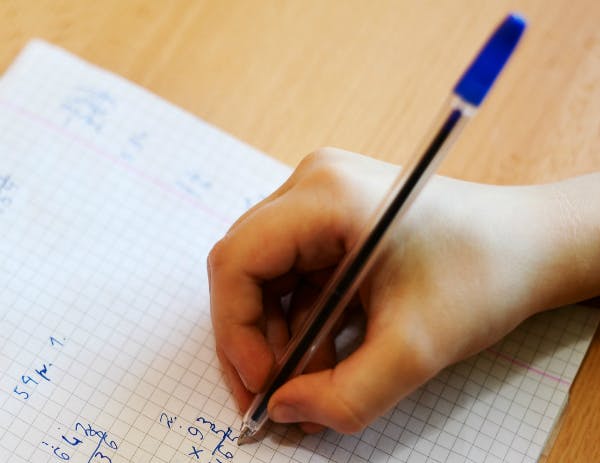
Best for: 2nd grade, 3rd grade
17. Multiplying 1-Digit Integers: Adrianna needs to cut a pan of brownies into pieces. She cuts 6 even columns and 3 even rows into the pan. How many brownies does she have?
18. Multiplying 2-Digit Integers: A movie theatre has 25 rows of seats with 20 seats in each row. How many seats are there in total?
19. Multiplying Integers Ending with 0: A clothing company has 4 different kinds of sweatshirts. Each year, the company makes 60,000 of each kind of sweatshirt. How many sweatshirts does the company make each year?
20. Multiplying 3 Integers: A bricklayer stacks bricks in 2 rows, with 10 bricks in each row. On top of each row, there is a stack of 6 bricks. How many bricks are there in total?
21. Multiplying 4 Integers: Cayley earns $5 an hour by delivering newspapers. She delivers newspapers 3 days each week, for 4 hours at a time. After delivering newspapers for 8 weeks, how much money will Cayley earn?
Division word problems
Best for: 3rd grade, 4th grade, 5th grade
22. Dividing 1-Digit Integers: If you have 4 pieces of candy split evenly into 2 bags, how many pieces of candy are in each bag?
23. Dividing 2-Digit Integers: If you have 80 tickets for the fair and each ride costs 5 tickets, how many rides can you go on?
24. Dividing Numbers Ending with 0: The school has $20,000 to buy new computer equipment. If each piece of equipment costs $50, how many pieces can the school buy in total?
25. Dividing 3 Integers: Melissa buys 2 packs of tennis balls for $12 in total. All together, there are 6 tennis balls. How much does 1 pack of tennis balls cost? How much does 1 tennis ball cost?
26. Interpreting Remainders: An Italian restaurant receives a shipment of 86 veal cutlets. If it takes 3 cutlets to make a dish, how many cutlets will the restaurant have left over after making as many dishes as possible?
Mixed operations word problems

27. Mixing Addition and Subtraction: There are 235 books in a library. On Monday, 123 books are taken out. On Tuesday, 56 books are brought back. How many books are there now?
28. Mixing Multiplication and Division: There is a group of 10 people who are ordering pizza. If each person gets 2 slices and each pizza has 4 slices, how many pizzas should they order?
29. Mixing Multiplication, Addition and Subtraction: Lana has 2 bags with 2 marbles in each bag. Markus has 2 bags with 3 marbles in each bag. How many more marbles does Markus have?
30. Mixing Division, Addition and Subtraction: Lana has 3 bags with the same amount of marbles in them, totaling 12 marbles. Markus has 3 bags with the same amount of marbles in them, totaling 18 marbles. How many more marbles does Markus have in each bag?
Ordering and number sense word problems
31. Counting to Preview Multiplication: There are 2 chalkboards in your classroom. If each chalkboard needs 2 pieces of chalk, how many pieces do you need in total?
32. Counting to Preview Division: There are 3 chalkboards in your classroom. Each chalkboard has 2 pieces of chalk. This means there are 6 pieces of chalk in total. If you take 1 piece of chalk away from each chalkboard, how many will there be in total?
33. Composing Numbers: What number is 6 tens and 10 ones?
34. Guessing Numbers: I have a 7 in the tens place. I have an even number in the ones place. I am lower than 74. What number am I?
35. Finding the Order: In the hockey game, Mitchell scored more points than William but fewer points than Auston. Who scored the most points? Who scored the fewest points?
Fractions word problems

Best for: 3rd grade, 4th grade, 5th grade, 6th grade
36. Finding Fractions of a Group: Julia went to 10 houses on her street for Halloween. 5 of the houses gave her a chocolate bar. What fraction of houses on Julia’s street gave her a chocolate bar?
37. Finding Unit Fractions: Heather is painting a portrait of her best friend, Lisa. To make it easier, she divides the portrait into 6 equal parts. What fraction represents each part of the portrait?
38. Adding Fractions with Like Denominators: Noah walks ⅓ of a kilometre to school each day. He also walks ⅓ of a kilometre to get home after school. How many kilometres does he walk in total?
39. Subtracting Fractions with Like Denominators: Last week, Whitney counted the number of juice boxes she had for school lunches. She had ⅗ of a case. This week, it’s down to ⅕ of a case. How much of the case did Whitney drink?
40. Adding Whole Numbers and Fractions with Like Denominators: At lunchtime, an ice cream parlor served 6 ¼ scoops of chocolate ice cream, 5 ¾ scoops of vanilla and 2 ¾ scoops of strawberry. How many scoops of ice cream did the parlor serve in total?
41. Subtracting Whole Numbers and Fractions with Like Denominators: For a party, Jaime had 5 ⅓ bottles of cola for her friends to drink. She drank ⅓ of a bottle herself. Her friends drank 3 ⅓. How many bottles of cola does Jaime have left?
42. Adding Fractions with Unlike Denominators: Kevin completed ½ of an assignment at school. When he was home that evening, he completed ⅚ of another assignment. How many assignments did Kevin complete?
43. Subtracting Fractions with Unlike Denominators: Packing school lunches for her kids, Patty used ⅞ of a package of ham. She also used ½ of a package of turkey. How much more ham than turkey did Patty use?
44. Multiplying Fractions: During gym class on Wednesday, the students ran for ¼ of a kilometre. On Thursday, they ran ½ as many kilometres as on Wednesday. How many kilometres did the students run on Thursday? Write your answer as a fraction.
45. Dividing Fractions: A clothing manufacturer uses ⅕ of a bottle of colour dye to make one pair of pants. The manufacturer used ⅘ of a bottle yesterday. How many pairs of pants did the manufacturer make?
46. Multiplying Fractions with Whole Numbers: Mark drank ⅚ of a carton of milk this week. Frank drank 7 times more milk than Mark. How many cartons of milk did Frank drink? Write your answer as a fraction, or as a whole or mixed number.
Decimals word problems
Best for: 4th grade, 5th grade
47. Adding Decimals: You have 2.6 grams of yogurt in your bowl and you add another spoonful of 1.3 grams. How much yogurt do you have in total?
48. Subtracting Decimals: Gemma had 25.75 grams of frosting to make a cake. She decided to use only 15.5 grams of the frosting. How much frosting does Gemma have left?
49. Multiplying Decimals with Whole Numbers: Marshall walks a total of 0.9 kilometres to and from school each day. After 4 days, how many kilometres will he have walked?
50. Dividing Decimals by Whole Numbers: To make the Leaning Tower of Pisa from spaghetti, Mrs. Robinson bought 2.5 kilograms of spaghetti. Her students were able to make 10 leaning towers in total. How many kilograms of spaghetti does it take to make 1 leaning tower?
51. Mixing Addition and Subtraction of Decimals: Rocco has 1.5 litres of orange soda and 2.25 litres of grape soda in his fridge. Antonio has 1.15 litres of orange soda and 0.62 litres of grape soda. How much more soda does Rocco have than Angelo?
52. Mixing Multiplication and Division of Decimals: 4 days a week, Laura practices martial arts for 1.5 hours. Considering a week is 7 days, what is her average practice time per day each week?
Comparing and sequencing word problems

Best for: Kindergarten, 1st grade, 2nd grade
53. Comparing 1-Digit Integers: You have 3 apples and your friend has 5 apples. Who has more?
54. Comparing 2-Digit Integers: You have 50 candies and your friend has 75 candies. Who has more?
55. Comparing Different Variables: There are 5 basketballs on the playground. There are 7 footballs on the playground. Are there more basketballs or footballs?
56. Sequencing 1-Digit Integers: Erik has 0 stickers. Every day he gets 1 more sticker. How many days until he gets 3 stickers?
57. Skip-Counting by Odd Numbers: Natalie began at 5. She skip-counted by fives. Could she have said the number 20?
58. Skip-Counting by Even Numbers: Natasha began at 0. She skip-counted by eights. Could she have said the number 36?
59. Sequencing 2-Digit Numbers: Each month, Jeremy adds the same number of cards to his baseball card collection. In January, he had 36. 48 in February. 60 in March. How many baseball cards will Jeremy have in April?
Time word problems
66. Converting Hours into Minutes: Jeremy helped his mom for 1 hour. For how many minutes was he helping her?
69. Adding Time: If you wake up at 7:00 a.m. and it takes you 1 hour and 30 minutes to get ready and walk to school, at what time will you get to school?
70. Subtracting Time: If a train departs at 2:00 p.m. and arrives at 4:00 p.m., how long were passengers on the train for?
71. Finding Start and End Times: Rebecca left her dad’s store to go home at twenty to seven in the evening. Forty minutes later, she was home. What time was it when she arrived home?
Money word problems
Best for: 1st grade, 2nd grade, 3rd grade, 4th grade, 5th grade
60. Adding Money: Thomas and Matthew are saving up money to buy a video game together. Thomas has saved $30. Matthew has saved $35. How much money have they saved up together in total?
61. Subtracting Money: Thomas has $80 saved up. He uses his money to buy a video game. The video game costs $67. How much money does he have left?
62. Multiplying Money: Tim gets $5 for delivering the paper. How much money will he have after delivering the paper 3 times?
63. Dividing Money: Robert spent $184.59 to buy 3 hockey sticks. If each hockey stick was the same price, how much did 1 cost?
64. Adding Money with Decimals: You went to the store and bought gum for $1.25 and a sucker for $0.50. How much was your total?
65. Subtracting Money with Decimals: You went to the store with $5.50. You bought gum for $1.25, a chocolate bar for $1.15 and a sucker for $0.50. How much money do you have left?
67. Applying Proportional Relationships to Money: Jakob wants to invite 20 friends to his birthday, which will cost his parents $250. If he decides to invite 15 friends instead, how much money will it cost his parents? Assume the relationship is directly proportional.
68. Applying Percentages to Money: Retta put $100.00 in a bank account that gains 20% interest annually. How much interest will be accumulated in 1 year? And if she makes no withdrawals, how much money will be in the account after 1 year?
Physical measurement word problems

Best for: 1st grade, 2nd grade, 3rd grade, 4th grade
72. Comparing Measurements: Cassandra’s ruler is 22 centimetres long. April’s ruler is 30 centimetres long. How many centimetres longer is April’s ruler?
73. Contextualizing Measurements: Picture a school bus. Which unit of measurement would best describe the length of the bus? Centimetres, metres or kilometres?
74. Adding Measurements: Micha’s dad wants to try to save money on gas, so he has been tracking how much he uses. Last year, Micha’s dad used 100 litres of gas. This year, her dad used 90 litres of gas. How much gas did he use in total for the two years?
75. Subtracting Measurements: Micha’s dad wants to try to save money on gas, so he has been tracking how much he uses. Over the past two years, Micha’s dad used 200 litres of gas. This year, he used 100 litres of gas. How much gas did he use last year?

76. Multiplying Volume and Mass: Kiera wants to make sure she has strong bones, so she drinks 2 litres of milk every week. After 3 weeks, how many litres of milk will Kiera drink?
77. Dividing Volume and Mass: Lillian is doing some gardening, so she bought 1 kilogram of soil. She wants to spread the soil evenly between her 2 plants. How much will each plant get?
78. Converting Mass: Inger goes to the grocery store and buys 3 squashes that each weigh 500 grams. How many kilograms of squash did Inger buy?
79. Converting Volume: Shad has a lemonade stand and sold 20 cups of lemonade. Each cup was 500 millilitres. How many litres did Shad sell in total?
80. Converting Length: Stacy and Milda are comparing their heights. Stacy is 1.5 meters tall. Milda is 10 centimetres taller than Stacy. What is Milda’s height in centimetres?
81. Understanding Distance and Direction: A bus leaves the school to take students on a field trip. The bus travels 10 kilometres south, 10 kilometres west, another 5 kilometres south and 15 kilometres north. To return to the school, in which direction does the bus have to travel? How many kilometres must it travel in that direction?
Ratios and percentages word problems
Best for: 4th grade, 5th grade, 6th grade
82. Finding a Missing Number: The ratio of Jenny’s trophies to Meredith’s trophies is 7:4. Jenny has 28 trophies. How many does Meredith have?
83. Finding Missing Numbers: The ratio of Jenny’s trophies to Meredith’s trophies is 7:4. The difference between the numbers is 12. What are the numbers?
84. Comparing Ratios: The school’s junior band has 10 saxophone players and 20 trumpet players. The school’s senior band has 18 saxophone players and 29 trumpet players. Which band has the higher ratio of trumpet to saxophone players?
85. Determining Percentages: Mary surveyed students in her school to find out what their favourite sports were. Out of 1,200 students, 455 said hockey was their favourite sport. What percentage of students said hockey was their favourite sport?
86. Determining Percent of Change: A decade ago, Oakville’s population was 67,624 people. Now, it is 190% larger. What is Oakville’s current population?
87. Determining Percents of Numbers: At the ice skate rental stand, 60% of 120 skates are for boys. If the rest of the skates are for girls, how many are there?
88. Calculating Averages: For 4 weeks, William volunteered as a helper for swimming classes. The first week, he volunteered for 8 hours. He volunteered for 12 hours in the second week, and another 12 hours in the third week. The fourth week, he volunteered for 9 hours. For how many hours did he volunteer per week, on average?
Probability and data relationships word problems

Best for: 4th grade, 5th grade, 6th grade, 7th grade
89. Understanding the Premise of Probability: John wants to know his class’s favourite TV show, so he surveys all of the boys. Will the sample be representative or biased?
90. Understanding Tangible Probability: The faces on a fair number die are labelled 1, 2, 3, 4, 5 and 6. You roll the die 12 times. How many times should you expect to roll a 1?
91. Exploring Complementary Events: The numbers 1 to 50 are in a hat. If the probability of drawing an even number is 25/50, what is the probability of NOT drawing an even number? Express this probability as a fraction.
92. Exploring Experimental Probability: A pizza shop has recently sold 15 pizzas. 5 of those pizzas were pepperoni. Answering with a fraction, what is the experimental probability that he next pizza will be pepperoni?
93. Introducing Data Relationships: Maurita and Felice each take 4 tests. Here are the results of Maurita’s 4 tests: 4, 4, 4, 4. Here are the results for 3 of Felice’s 4 tests: 3, 3, 3. If Maurita’s mean for the 4 tests is 1 point higher than Felice’s, what’s the score of Felice’s 4th test?
94. Introducing Proportional Relationships: Store A is selling 7 pounds of bananas for $7.00. Store B is selling 3 pounds of bananas for $6.00. Which store has the better deal?
95. Writing Equations for Proportional Relationships: Lionel loves soccer, but has trouble motivating himself to practice. So, he incentivizes himself through video games. There is a proportional relationship between the amount of drills Lionel completes, in x , and for how many hours he plays video games, in y . When Lionel completes 10 drills, he plays video games for 30 minutes. Write the equation for the relationship between x and y .
Geometry word problems
Best for: 4th grade, 5th grade, 6th grade, 7th grade, 8th grade
96. Introducing Perimeter: The theatre has 4 chairs in a row. There are 5 rows. Using rows as your unit of measurement, what is the perimeter?
97. Introducing Area: The theatre has 4 chairs in a row. There are 5 rows. How many chairs are there in total?
98. Introducing Volume: Aaron wants to know how much candy his container can hold. The container is 20 centimetres tall, 10 centimetres long and 10 centimetres wide. What is the container’s volume?
99. Understanding 2D Shapes: Kevin draws a shape with 4 equal sides. What shape did he draw?
100. Finding the Perimeter of 2D Shapes: Mitchell wrote his homework questions on a piece of square paper. Each side of the paper is 8 centimetres. What is the perimeter?
101. Determining the Area of 2D Shapes: A single trading card is 9 centimetres long by 6 centimetres wide. What is its area?
102. Understanding 3D Shapes: Martha draws a shape that has 6 square faces. What shape did she draw?
103. Determining the Surface Area of 3D Shapes: What is the surface area of a cube that has a width of 2cm, height of 2 cm and length of 2 cm?
104. Determining the Volume of 3D Shapes: Aaron’s candy container is 20 centimetres tall, 10 centimetres long and 10 centimetres wide. Bruce’s container is 25 centimetres tall, 9 centimetres long and 9 centimetres wide. Find the volume of each container. Based on volume, whose container can hold more candy?
105. Identifying Right-Angled Triangles: A triangle has the following side lengths: 3 cm, 4 cm and 5 cm. Is this triangle a right-angled triangle?
106. Identifying Equilateral Triangles: A triangle has the following side lengths: 4 cm, 4 cm and 4 cm. What kind of triangle is it?
107. Identifying Isosceles Triangles: A triangle has the following side lengths: 4 cm, 5 cm and 5 cm. What kind of triangle is it?
108. Identifying Scalene Triangles: A triangle has the following side lengths: 4 cm, 5 cm and 6 cm. What kind of triangle is it?
109. Finding the Perimeter of Triangles: Luigi built a tent in the shape of an equilateral triangle. The perimeter is 21 metres. What is the length of each of the tent’s sides?
110. Determining the Area of Triangles: What is the area of a triangle with a base of 2 units and a height of 3 units?
111. Applying Pythagorean Theorem: A right triangle has one non-hypotenuse side length of 3 inches and the hypotenuse measures 5 inches. What is the length of the other non-hypotenuse side?
112. Finding a Circle’s Diameter: Jasmin bought a new round backpack. Its area is 370 square centimetres. What is the round backpack’s diameter?
113. Finding a Circle's Area: Captain America’s circular shield has a diameter of 76.2 centimetres. What is the area of his shield?
114. Finding a Circle’s Radius: Skylar lives on a farm, where his dad keeps a circular corn maze. The corn maze has a diameter of 2 kilometres. What is the maze’s radius?
Variables word problems
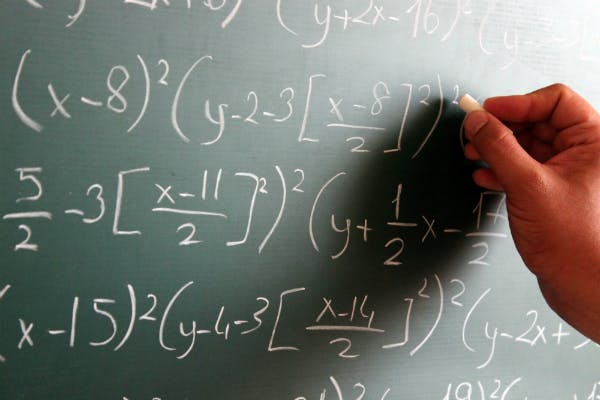
Best for: 6th grade, 7th grade, 8th grade
115. Identifying Independent and Dependent Variables: Victoria is baking muffins for her class. The number of muffins she makes is based on how many classmates she has. For this equation, m is the number of muffins and c is the number of classmates. Which variable is independent and which variable is dependent?
116. Writing Variable Expressions for Addition: Last soccer season, Trish scored g goals. Alexa scored 4 more goals than Trish. Write an expression that shows how many goals Alexa scored.
117. Writing Variable Expressions for Subtraction: Elizabeth eats a healthy, balanced breakfast b times a week. Madison sometimes skips breakfast. In total, Madison eats 3 fewer breakfasts a week than Elizabeth. Write an expression that shows how many times a week Madison eats breakfast.
118. Writing Variable Expressions for Multiplication: Last hockey season, Jack scored g goals. Patrik scored twice as many goals than Jack. Write an expression that shows how many goals Patrik scored.
119. Writing Variable Expressions for Division: Amanda has c chocolate bars. She wants to distribute the chocolate bars evenly among 3 friends. Write an expression that shows how many chocolate bars 1 of her friends will receive.
120. Solving Two-Variable Equations: This equation shows how the amount Lucas earns from his after-school job depends on how many hours he works: e = 12h . The variable h represents how many hours he works. The variable e represents how much money he earns. How much money will Lucas earn after working for 6 hours?
How to easily make your own math word problems & word problems worksheets

Armed with 120 examples to spark ideas, making your own math word problems can engage your students and ensure alignment with lessons. Do:
- Link to Student Interests: By framing your word problems with student interests, you’ll likely grab attention. For example, if most of your class loves American football, a measurement problem could involve the throwing distance of a famous quarterback.
- Make Questions Topical: Writing a word problem that reflects current events or issues can engage students by giving them a clear, tangible way to apply their knowledge.
- Include Student Names: Naming a question’s characters after your students is an easy way make subject matter relatable, helping them work through the problem.
- Be Explicit: Repeating keywords distills the question, helping students focus on the core problem.
- Test Reading Comprehension: Flowery word choice and long sentences can hide a question’s key elements. Instead, use concise phrasing and grade-level vocabulary.
- Focus on Similar Interests: Framing too many questions with related interests -- such as football and basketball -- can alienate or disengage some students.
- Feature Red Herrings: Including unnecessary information introduces another problem-solving element, overwhelming many elementary students.
A key to differentiated instruction , word problems that students can relate to and contextualize will capture interest more than generic and abstract ones.
Final thoughts about math word problems
You’ll likely get the most out of this resource by using the problems as templates, slightly modifying them by applying the above tips. In doing so, they’ll be more relevant to -- and engaging for -- your students.
Regardless, having 120 curriculum-aligned math word problems at your fingertips should help you deliver skill-building challenges and thought-provoking assessments.
The result?
A greater understanding of how your students process content and demonstrate understanding, informing your ongoing teaching approach.

In order to continue enjoying our site, we ask that you confirm your identity as a human. Thank you very much for your cooperation.

3 Word Problem Solving Strategies To Improve Word Problem Performance
This post contains affiliate links. This means that when you make a purchase, at no additional cost to you, I will earn a small commission.
The ability to solve word problems doesn’t necessarily come easily to all students. We can improve our students’ ability to solve story problems with a few simple word problem-solving strategies. When it comes to comprehending, understanding, and solving word problems, sometimes it is helpful to move beyond traditional word problems and try a new word problem type that is designed to support students in tackling these tricky skills!
In order to solve word problems, students need to be able to:
- Comprehend the action or context of a word problem
- Understand the question or missing piece of information
- Develop a mathematically sound plan for solving for the missing information.
- Accurately calculate to find their solution.
It’s a balance between comprehension, an understanding of math concepts, and an ability to carry out math concepts. Identifying which of these steps are strengths or needs for your students can help you to choose a strategy that will best improve their word problem performance.
Word Problem Solving Strategy #1: Numberless Word Problems
Who is this strategy for? If your students are struggling to understand the action, context or question in a story problem, discussion and numberless word problems will be a word problem-solving strategy that can help your students tremendously! This strategy also helps your “number pluckers” who see numbers, pluck and add together regardless of context! Numberless word problems slow your students down!
Using a tool such as numberless word problems can help your students in their understanding precisely because the numberless word problem strategy emphasizes discussion every step of the way!
How do I use this strategy? As you solve numberless word problems you begin with a problem with no numbers at all and ask a variety of questions as you discuss and slowly add information back into the problem.
Reagan picked flowers for a bouquet! She picked both roses and carnations.
When you initially present the problem, ask your students questions such as
- Who is the story problem about?
- What is happening in this story?
- What are you wondering about?
Reagan picked flowers for a bouquet! She picked 7 roses and also some carnations.
- What new information do we have?
- What do you think we might learn next?
- What *could* be the number of carnations in the bouquet? What might make sense?
Reagan picked flowers for a bouquet! She picked 7 roses and 8 carnations.
- What new information do we know?
- What do you know about the story?
- What happened in the story?
- Could we draw a picture or diagram to match the story?
- What might we be wondering about the bouquet?
- What questions could we answer about the bouquet?
Reagan picked flowers for a bouquet! She picked 7 roses and 8 carnations. How many flowers are in the bouquet in all?
- What is the question wondering?
- Do we have enough information to answer that question?
- Where do we see the 7 roses in our diagram?
- Where do we see the 8 carnations in our diagram?
- How can we use the diagram to answer the question of how many flowers are in the bouquet in all?
DONE FOR YOU NUMBERLESS WORD PROBLEMS
Kindergarten | 1st Grade | 2nd Grade | 3rd Grade | 4th Grade
Word Problem Solving Strategy #2: Guided Visual Models
Who is this strategy for? Visual models help your students to organize the information they know as well as to visualize the missing piece of information. Drawing visual models helps lead your students to an equation. This strategy is ideal for students who understand what a word problem is asking but have difficulty connecting the action of a word problem to an equation.
A visual model might include:
- A math drawing (simple circles or an organic representation)
- A number bond (number bonds can be used beyond addition and subtraction! Adding more “parts” can help to visualize multiplication and division as well!)
- Tape diagrams
How can I use this strategy? As you are supporting your students in using these visual models, continually ask questions and draw connections between the word problem and their diagram.
Frank built a tower using 16 blocks. He took 7 blocks off of his tower and gave them to Declan so he could build a tower as well. How many blocks does Frank have left?
- Could you draw a picture that shows what happened?
- Frank had 16 blocks. Was that all of the blocks in the story or part of them? Where would we put the total in our number bond?
- Frank gave away 7 blocks. Was that all of the blocks or a part of the blocks? Where would we put the part in our number bond?
- And we’re wondering how many blocks Frank has left. Where is the missing part in our number bond? Could we write a question mark in that part?
If your students are familiar with number bonds or tape diagrams, knowing that they are missing a part will lead them to writing a subtraction equation or a missing addend addition equation to solve.
**If your students are not familiar with how to find a missing part or missing whole in an equation this is a topic that needs to be addressed as well! Your students are missing foundational math understandings that are critical to their word problem-solving strategy. Additional practice with both fact families and missing numbers in an equation will be helpful to your students!
Word Problem Strategy #3: Problem Sorts
Who is this strategy for? This strategy is for ALL students! When your students examine problems to help understand the underlying structures and problem types , solving word problems becomes easier.
If you were to be asked to cook dinner for a group of people at the drop of a hat, you would likely have a much easier time putting together a pizza than you would a complicated curry dish. You understand the underlying structure of a pizza- crust, sauce, cheese, toppings- and because you know this structure, given any different type of pizza (BBQ, Traditional, Garlic, Buffalo Chicken) you would be able to use the structure to come up with a recipe quickly and easily.
Understanding and recognizing problem types can do the same thing for our students! Understanding that in a “put together” problem there are going to be parts and that those parts can be put together using addition makes these problems much easier to solve!
How can I use this strategy? One way to help your students to recognize and understand problem types is to sort word problems. In a problem sort, you aren’t attending to the matter of solving the problem at all . Instead, you are reading the problems and sorting them based on whether the problem is missing a part or missing the total. If you are working on multiplication and division word problems you might sort based on whether the problem is missing the total , missing the number of groups or missing the group size. Other problem types will lend themselves to different sorting activities.

Additional Word Problem Resources
Using different types of word problem resources can help you to support your students in different ways.
Word Problem Sort Cards can be a useful tool when you want your students to attend to the structure of math problems. Sort the cards based on problem type or based on the operation your students would use to solve. After sorting, solve the problems together. Reuse the sort as a math center!
Word Problem Notebooks are a useful tool when you want your students to draw models and visual representations of word problems and to connect these models to an equation.
Numberless Word Problems help get to the heart of the action or context of a word problem. Because you start with no numbers and employ a great deal of conversation these problems are simple to differentiate and give all students a point of access into the activity.
- Read more about: Uncategorized
You might also like...

Hands-On Fraction Materials

Simplifying Math Intervention Data

3 Engaging Ways to Anchor Your Math Intervention Lesson
Find it here.

Let's Connect
Search the site.
© The Math Spot • Website by KristenDoyle.co
Why Word Problems Are Such a Struggle for Students—And What Teachers Can Do

- Share article
Give Cindy Cliche a math word problem, and she can tell you exactly where most students are going to trip up.
Cliche, the district math coordinator in the Murfreesboro City school district in Tennessee, has spent decades teaching elementary schoolers how to tackle their first word problems and now coaches teachers in how to do the same. Kids’ struggles, for the most part, haven’t changed, she said.
Take this problem, which students might work on in 1st grade: There are some bunnies on the grass. Three bunnies hop over, and then there are five total. How many bunnies were there to begin with?
The problem is asking about a change: What’s the starting, unknown quantity of bunnies, if adding 3 to that quantity equals 5? In other words, x + 3 = 5 . But most 1st graders don’t make that connection right away, Cliche said. Instead, they see the numbers 3 and 5, and they add them.
“Nine times out of 10 they’re going to say, ‘eight,’” Cliche said. “They’re number pluckers. They take this number and this number and they add them together or they take them apart.”
This is one of the biggest challenges in word problem-solving, educators and researchers agree—getting students to understand that the written story on the page represents a math story, and that the math story can be translated into an equation.
Making this connection is a key part of early mathematical sense-making. It helps students begin to understand that math isn’t just about numbers on a page, but a way of representing relationships in the world. And it’s one of the ways that kids learn to unite conceptual understanding of problems with the procedures they will need to solve them.
“When students struggle [with word problems], it tends to be everything else they have to do to get to the calculation,” said Brian Bushart, a 4th grade teacher in the West Irondequoit schools in Rochester, N.Y.
There are evidence-backed strategies that teachers can use to help students make these connections, researchers say.
These approaches teach students how to understand “math language,” how to devise a plan of attack for a problem, and how to recognize different problem types. And though they provide students tools and explicit strategies, these techniques are designed to support kids’ sense-making, not circumvent it, said Lynn Fuchs, a research professor in the department of special education at Vanderbilt University.
The goal, she said, is “understanding the full narrative of what’s being presented.”
How word problems are used in early grades
Story problems serve a few different purposes in early grades, said Nicole McNeil, a professor of psychology at the University of Notre Dame who studies students’ cognitive development in math.
They can help connect children’s preexisting knowledge to the math they’re learning in class—"activating that knowledge kids have in their everyday life, and then showing, how do mathematicians represent that?” McNeil said.
Cliche likes to use word problems in this way to introduce the concept of dividing by fractions.
“We’ll tell the kids, ‘I have three sandwiches here and I need to divide them in half so that everyone will get a piece,’” she said. “‘How many people can I feed?’”
After students solve the problem, Cliche introduces the operation that students could use to divide by fractions—marrying this conceptual understanding with the procedure that students would use going forward.
But word problems can also be used in the opposite direction, to see if students can apply their understanding of equations they’ve learned to real-world situations, McNeil said.
And there’s another, practical reason that teachers practice word problems: They’re ubiquitous in curriculum and they’re frequently tested.
There are lots of different kinds of problems that kids could work on in math classes, said Tamisha Thompson, a STEAM (for science, technology, engineering, the arts, and math) instructional coach in the Millbury public schools in Massachusetts, and a doctoral student in learning sciences at Worcester Polytechnic Institute.
Many story problems have one right answer, but there are also problems that could have multiple answers—or ones that aren’t solvable. Spending more time with a broader diversity of problems could encourage more creative mathematical thinking, Thompson said. “But we’re really driven by standardized tests,” she said. “And standardized tests typically have one right answer.”
In general, between 30 percent and 50 percent of standardized-test items in math feature these kinds of story problems, said Sarah Powell, an associate professor in the department of special education at the University of Texas at Austin.
“Until things change, and until we write better and different tests, if you want students to show their math knowledge, they have to show that through word problem-solving,” Powell said.
Why students struggle with word problems
Sometimes, students struggle with word problems because they don’t know where to start.
Just reading the problem can be the first hurdle. If early-elementary schoolers don’t have the reading skills to decode the words, or if they don’t know some of the vocabulary, they’ll struggle, said McNeil.
That can result in students scoring low on these portions of standardized tests, even if they understand the underlying math concepts—something McNeil considers to be a design flaw. “You’re trying to assess math, not reading twice,” she said.
Then, there’s math-specific vocabulary. What do words like “fewer than,” or “the rest,” mean in math language, and how do they prompt different actions depending on their placement in a problem?
Even if students can read the problem, they may struggle to figure out what it’s asking them to do, said Powell. They need to identify relevant information and ignore irrelevant information—including data that may be presented in charts or graphs. Then, they have to choose an operation to use to solve the problem.
Only once students have gone through all these steps do they actually perform a calculation.
Teaching kids how to work through all these setup steps takes time. But it’s time that a lot of schools don’t take, said Cliche, who has also worked previously as a state math trainer for Tennessee. Word problems aren’t often the focus of instruction—rather, they’re seen as a final exercise in transfer after a lot of practice with algorithms, she said.
A second problem: Many schools teach shortcut strategies for deciphering word problems that aren’t effective, Powell said.
Word problem “key words” charts abound on lesson-sharing sites like Teachers Pay Teachers . These graphic organizers are designed to remind students which math words signal different operations. When you see the word “more,” for example, that means add the numbers in the problem.
Talking with students about the meaning of math vocabulary is useful, said Powell. But using specific words as cues to add or subtract is a flawed strategy, Powell said, because “there is no single word that means an operation.” The word “more” might mean that the numbers need to be added together—or it might mean something else in context. Some problems have no key words at all.
In a 2022 paper , Powell and her colleagues analyzed more than 200 word problems from Partnership for Assessment of Readiness for College and Careers (PARCC) and Smarter Balanced math tests in elementary and middle school grades. Those tests are given by states for federal accountability purposes.
They found that using the key words strategy would lead students to choose the right operation to solve the problem less than half the time for single-step problems and less than 10 percent of the time for multistep problems.
Evidence-based strategies for helping struggling students
So if key words aren’t an effective strategy to support students who struggle, what is?
One evidence-based approach is called schema-based instruction . This approach categorizes problems into different types, depending on the math event portrayed, said Fuchs, who has studied schema-based instruction for more than two decades.
But unlike key words, schemas don’t tell students what operations to use. Instead, they help students form a mental model of a math event. They still need to read the problem, understand how that story maps onto their mental model, and figure out what information is missing, Fuchs said.
One type of schema, for example, is a “total” or “combine” problem, in which two quantities together make a total: “Jose has five apples. Carlos has two apples. How many apples do they have together?” In this case, students would need to add to get the answer.
But this is also a total problem: “Together, Jose and Carlos have seven apples. If Jose has five apples, how many apples does Carlos have?”
Here, adding the two numbers in the problem would bring students to the wrong answer. They need to understand that seven is the total, five is one part of the total, and there is another, unknown part—and then solve from there.
To introduce schemas, Vanderbilt’s Fuchs said, “we start with a child and the teacher representing the mathematical event in a concrete way.”
Take a “difference” problem, which compares a larger quantity and a smaller quantity for a difference. To demonstrate this, an early-elementary teacher might show the difference in height between two students or the difference in length of two posters in the room.
Eventually, the teacher would introduce other ways of representing this “difference” event, like drawing one smaller and one larger rectangle on a piece of paper. Then, Fuchs said, the teacher would explain the “difference” event with a number sentence—the formula for calculating difference—to connect the conceptual understanding with the procedure. Students would then learn a solution strategy for the schema.
Children can then use their understanding of these different problem types to solve new problems, Fuchs said.
There are other strategies for word-problem-solving, too.
- Attack strategies . Several studies have found that giving students a consistent set of steps they can use to approach every problem has positive effects. These attack strategies are different from schemas because they can be used with any problem type, offering more general guidance like reminders to read the problem and pull out relevant information.
- Embedded vocabulary. A 2021 study from Fuchs and her colleagues found that math-specific vocabulary instruction helped students get better at word problem-solving. These vocabulary lessons were embedded into schema instruction, and they focused on words that had a specific meaning in a math context—teaching kids the difference between “more than” and “then there were more,” for example.
- ‘Numberless’ problems . Some educators have also developed their own strategies. One of these is what’s called “numberless” word problems. A numberless problem has the same structure as a regular story problem but with the quantities strategically removed. An initial statement might say, for example, “Kevin found some bird feathers in the park. On his way home, he lost some of the feathers.”
With numberless problems, instead of jumping to the calculation, “the conversation is the goal,” said Bushart, the 4th grade teacher from New York, who has created a website bank of numberless problems that teachers can use .
The teacher talks with students about the change the story shows and what numbers might be reasonable—and not reasonable. The process is a form of scaffolding, Bushart said: a way to get students thinking conceptually about problems from the start.
Balancing structure and challenge
These approaches all rely on explicit teaching to give students tools that can help them succeed with problems they’re likely to see often in class or on tests.
But many math educators also use word problems that move beyond these common structures, in an attempt to engage students in creative problem-solving. Figuring out how much structure to provide—and how much challenge—can be a delicate balance.
These kinds of problems often require that students integrate real-life knowledge, and challenge them to “think beyond straightforward applications of mathematical situations,” said McNeil of Notre Dame.
There may be an extra number in the problem that kids don’t have to use. Or the problem might pose a question that would lead students to a nonsensical answer if they just used their procedural knowledge. For example: 65 students are going on a field trip. If each bus can hold 10 students, how many buses are needed?
Students might do the calculation and answer this question with 6.5, but that number doesn’t make sense, said McNeil—you can’t have half a bus.
In a 2021 study , McNeil and her colleague Patrick Kirkland rewrote some of these challenging questions in a way that encouraged students to think more deeply about the problems. They found that middle school students who worked on these experimental problems were more likely than their peers to engage in deep mathematical thinking. But, they were also less likely to get the problems correct than their peers who did standard word problems.
Other research, with young children, has found that teaching students how to transfer their knowledge can help them work through novel problems.
When students are given only problems that are all structured the same way, even minor changes to that format can prevent them from recognizing problem schemas, said Fuchs.
“What we found in our line of work is that if you change the way the word problem reads, in only very minor ways, they no longer recognize that, this is a ‘change’ problem, or a ‘difference’ problem,” she said, referencing different problem schemas.
In the early 2000s, she and her colleagues tested interventions to help students transfer their knowledge to more complex, at times open-ended problems. They found that when children were taught about the notion of transfer, shown examples of different forms of the same problem type, and encouraged to find examples in their own lives, they performed better on novel, multistep problems than their peers who had only received schema instruction.
The results are an example of how explicit instruction can lay the groundwork for students to be successful with more open-ended problem-solving, Fuchs said.
Exactly how to sequence this learning—when to lean into structure and when to release students into challenge—is an open question, McNeil said.
“We need more researchers focused on what are the best structures? What order should things go in? What is the appropriate scope and sequence for word problems?” she said. “We don’t have that information yet.”
A version of this article appeared in the May 10, 2023 edition of Education Week as Why Word Problems Are Such a Struggle for Students—And What Teachers Can Do

Sign Up for EdWeek Update
Edweek top school jobs.

Sign Up & Sign In


Problem Solving the Thinking Blocks® Way!
We updated our thinking blocks suite of learning tools with all new features. read aloud word problems - visual prompts - better models - engaging themes - mobile friendly.

Thinking Blocks Junior
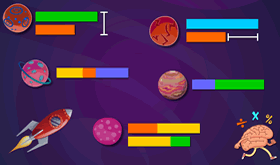
Thinking Blocks Addition
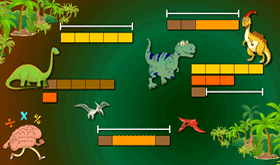
Thinking Blocks Multiplication
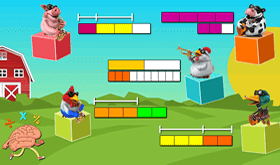
Thinking Blocks Fractions
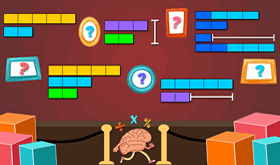
Thinking Blocks Ratios
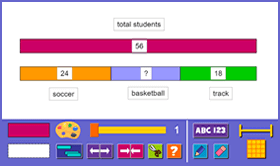
Thinking Blocks Tool

Part-Whole A

Part-Whole B

Mixed Operations
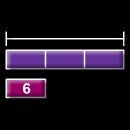
Critical Thinking
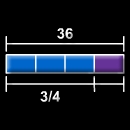
Fraction of a Set A
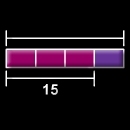
Fraction of a Set B
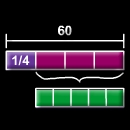
Fraction of a Set C
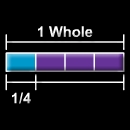
Add and Subtract A
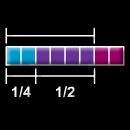
Add and Subtract B
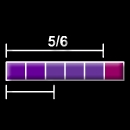
Multiply and Divide
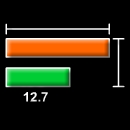
% of a Number
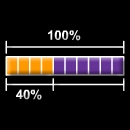
Taxes, Tips, Sales
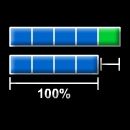
% Challenge A
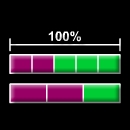
% Challenge B
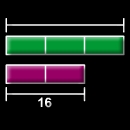
Three Quantities
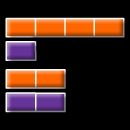
Word Problem Calculator
Get detailed solutions to your math problems with our word problem step-by-step calculator . practice your math skills and learn step by step with our math solver. check out all of our online calculators here ., example, solved problems, difficult problems, are you struggling with math.
Access detailed step by step solutions to thousands of problems, growing every day!
Popular problems
Most popular problems solved with this calculator:

Word Problems Activities
Teach your child all about word problems with amazing educational resources for children. These online word problems learning resources break down the topic into smaller parts for better conceptual understanding and grasp. Get started now to make word problems practice a smooth, easy and fun process for your child!

CONTENT TYPE
- Lesson Plans
- Math (8,010)
- Number Sense (1,256)
- Number Recognition (50)
- Number Recognition Within 5 (17)
- Number Recognition Within 10 (17)
- Number Recognition Within 20 (16)
- Number Tracing (470)
- Number Tracing Within 5 (135)
- Number Tracing Within 10 (125)
- Number Tracing Within 20 (210)
- Number Sequence (83)
- Counting (273)
- Counting Objects Within 5 (105)
- Counting Objects Within 10 (106)
- Counting Objects Within 20 (17)
- Compare Numbers (127)
- Compare Objects (17)
- Compare Numbers Using Place Value (29)
- Compare 2-Digit Numbers (6)
- Compare 3-Digit Numbers (19)
- Order Numbers (37)
- Order 3-Digit Numbers (10)
- Skip Counting (49)
- Skip Count By 2 (9)
- Skip Count By 5 (9)
- Skip Count By 10 (23)
- Skip Count By 100 (4)
- Even And Odd Numbers (27)
- Place Value (143)
- Teen Numbers (15)
- Word Form (5)
- Expanded And Standard Form (14)
- Unit Form (4)
- Round Numbers (47)
- Round Numbers To The Nearest 10 (18)
- Round Numbers To The Nearest 100 (14)
- Addition (1,211)
- Add With Pictures (180)
- Addition Properties (27)
- Commutative Property Of Addition (10)
- Addition Strategies (311)
- Compose And Decompose Numbers (138)
- Number Bonds (19)
- Count All To Add (21)
- Add Using A Number Line (19)
- Count On To Add (23)
- Add With 10 (24)
- Doubles And Near Doubles Addition Strategy (37)
- Make 10 Strategy (18)
- Add Using Multiples Of 10 (8)
- Add Three Whole Numbers (73)
- 2-Digit Addition (124)
- 2-Digit Addition Without Regrouping (60)
- 2-Digit Addition With Regrouping (26)
- 3-Digit Addition (170)
- 3-Digit Addition Without Regrouping (82)
- 3-Digit Addition With Regrouping (55)
- 4-Digit Addition (60)
- 4-Digit Addition Without Regrouping (25)
- 4-Digit Addition With Regrouping (29)
- Large Numbers Addition (63)
- 5-Digit Addition (30)
- 6-Digit Addition (25)
- Subtraction (957)
- Subtract With Pictures (110)
- Subtraction Strategies (107)
- Count Back Strategy (13)
- Subtract Using A Number Line (14)
- Doubles And Near Doubles Subtraction Strategy (6)
- Subtract From 10 Strategy (10)
- Subtract Using Multiples Of 10 (7)
- 2-Digit Subtraction (174)
- 2-Digit Subtraction Without Regrouping (97)
- 2-Digit Subtraction With Regrouping (30)
- 3-Digit Subtraction (173)
- 3-Digit Subtraction Without Regrouping (87)
- 3-Digit Subtraction With Regrouping (45)
- 4-Digit Subtraction (75)
- 4-Digit Subtraction Without Regrouping (36)
- 4-Digit Subtraction With Regrouping (35)
- Large Numbers Subtraction (114)
- 5-Digit Subtraction (54)
- 6-Digit Subtraction (49)
- Multiplication (666)
- Multiplication Strategies (154)
- Multiplication With Equal Groups (41)
- Multiplication With Arrays (44)
- Multiplication Sentences (64)
- Multiplication On A Number Line (13)
- Repeated Addition To Multiply (32)
- Times Tables (155)
- Multiplication By 2 (15)
- Multiplication By 3 (16)
- Multiplication By 4 (14)
- Multiplication By 5 (18)
- Multiplication By 6 (14)
- Multiplication By 7 (12)
- Multiplication By 8 (13)
- Multiplication By 9 (13)
- Multiplication By 10 (10)
- Multiplication By 11 (12)
- Multiplication By 12 (12)
- Multiplication Properties (143)
- Commutative Property Of Multiplication (10)
- Distributive Property Of Multiplication (77)
- Multiply By Multiples Of 10 (60)
- Estimate Products (12)
- Multi-Digit Multiplication (192)
- Multiply 2-Digit By 1-Digit Numbers (44)
- Multiply 2-Digit By 2-Digit Numbers (58)
- Multiply 3-Digit By 1-Digit Numbers (20)
- Multiply 3-Digit By 2-Digit Numbers (30)
- Multiply 4-Digit By 1-Digit Numbers (18)
- Division (422)
- Divide On A Number Line (13)
- Division Facts (158)
- Division By 2 (15)
- Division By 3 (15)
- Division By 4 (15)
- Division By 5 (15)
- Division By 6 (15)
- Division By 7 (15)
- Division By 8 (15)
- Division By 9 (15)
- Division By 10 (14)
- Estimate Quotients (19)
- Long Division (105)
- Divide 2-Digit By 1-Digit Numbers (23)
- Divide 3-Digit By 1-Digit Numbers (27)
- Divide 4-Digit By 1-Digit Numbers (21)
- Divide 4-Digit By 2-Digit Numbers (7)
- Fractions (615)
- Fractions Using Models (79)
- Fractions On A Number Line (26)
- Compare Fractions (64)
- Compare Fractions Using Models (16)
- Compare Fractions Using A Number Line (10)
- Order Fractions (20)
- Order Fractions Using Models (10)
- Equivalent Fractions (60)
- Equivalent Fractions Using Models (19)
- Equivalent Fractions Using A Number Line (10)
- Improper Fractions As Mixed Numbers (12)
- Mixed Numbers As Improper Fractions (4)
- Fractions Operations (338)
- Add Fractions (58)
- Add Fractions Using Models (23)
- Add Like Fractions (26)
- Add Unlike Fractions (12)
- Estimate Fraction Sums (7)
- Subtract Fractions (47)
- Subtract Fractions Using Models (21)
- Subtract Like Fractions (18)
- Subtract Unlike Fractions (11)
- Add Mixed Numbers (51)
- Add Mixed Numbers Using Models (12)
- Add A Mixed Number To A Fraction (14)
- Subtract Mixed Numbers (54)
- Subtract Mixed Numbers Using Models (11)
- Subtract A Fraction From A Mixed Number (19)
- Multiply Fractions (65)
- Multiply Fractions Using Models (18)
- Multiply Fractions By Whole Numbers (42)
- Multiply Mixed Numbers (32)
- Multiply Mixed Numbers By Whole Numbers (10)
- Multiply Mixed Numbers By Fractions (10)
- Divide Fractions (10)
- Scaling Fractions (10)
- Decimals (1,835)
- Read And Write Decimals (113)
- Decimals Using Models (22)
- Decimals On A Number Line (18)
- Decimal Place Value (71)
- Expanded Form Of Decimals (7)
- Word Form Of Decimals (10)
- Compare Decimals (53)
- Compare Decimals Using Models (10)
- Compare Decimals Using A Number Line (11)
- Order Decimals (27)
- Round Decimals (42)
- Round Decimals To The Nearest Whole (13)
- Round Decimals To The Nearest Tenths (10)
- Round Decimals To The Nearest Hundredths (10)
- Convert Decimals To Fractions (11)
- Decimal Operations (1,587)
- Add Decimals (382)
- Subtract Decimals (387)
- Multiply Decimals (263)
- Multiply Decimals By Powers Of 10 (27)
- Multiply Decimals By Whole Numbers (75)
- Divide Decimals (170)
- Divide Decimals By Powers Of 10 (18)
- Divide Decimals By Whole Numbers (52)
- Divide Whole Numbers By Decimals (45)
- Geometry (284)
- Positional Words (15)
- Lines, Line Segments, Rays (6)
- Parallel And Perpendicular Lines (5)
- Angles (22)
- Shapes (178)
- 2D Shapes (143)
- Attributes Of 2D Shapes (45)
- Polygons (11)
- Triangles (15)
- Quadrilaterals (26)
- 3D Shapes (31)
- 3D Shapes In Real Life (10)
- Partition Into Equal Parts (29)
- Partition In Halves, Thirds, And Fourths (24)
- Coordinate Plane (27)
- Read Points On The Coordinate Plane (10)
- Plot Points On The Coordinate Plane (10)
- Data Handling (75)
- Sorting Objects (18)
- Bar Graphs (12)
- Line Plots (13)
- Picture Graphs (10)
- Measurement (204)
- Length (57)
- Measure Lengths Using The Ruler (16)
- Estimate Lengths (8)
- Comparing Lengths (27)
- Height (16)
- Comparing Heights (16)
- Weight (23)
- Comparing Weights (10)
- Capacity (22)
- Conversion Of Measurement Units (27)
- Perimeter (25)
- Volume (11)
- Am And Pm (11)
- Time In Hours (25)
- Time In Half Hours (20)
- Time In Quarter Hours (21)
- Time To The Nearest 5 Minutes (27)
- Time To The Nearest Minute (3)
- Digital Clock (19)
- Elapsed Time (5)
- Money (131)
- Identify Coins (37)
- Counting Money (37)
- Compare Money (20)
- Add And Subtract Money (31)
- Multiply And Divide Money (9)
- Algebra (163)
- Number Patterns (49)
- Expressions And Equations (48)
- Evaluate Exponents (11)
- Order Of Operations (18)
- Factors And Multiples (51)
- Prime And Composite Numbers (15)
- Word Problems (755)
- Addition Word Problems (175)
- Addition Word Problems Within 20 (82)
- 2-Digit Addition Word Problems (28)
- 3-Digit Addition Word Problems (18)
- Decimal Addition Word Problems (25)
- Subtraction Word Problems (124)
- Subtraction Word Problems Within 20 (65)
- 2-Digit Subtraction Word Problems (12)
- Decimal Subtraction Word Problems (25)
- Multiplication Word Problems (115)
- Decimal Multiplication Word Problems (28)
- Division Word Problems (77)
- Decimal Division Word Problems (11)
- Multi-Step Word Problems (81)
- Fraction Word Problems (44)
- Money Word Problems (23)
- ELA (7,781)
- Reading (5,484)
- Phonics (5,185)
- Bossy R (77)
- Words With Ar (12)
- Words With Er (8)
- Words With Ir (8)
- Words With Or (7)
- Words With Ur (8)
- Diphthongs (46)
- Words With Oi (11)
- Words With Ou (11)
- Words With Ow (11)
- Words With Oy (11)
- Consonant Blends (232)
- Ending Blends (120)
- Beginning Blends (113)
- L Blend Words (52)
- R Blend Words (48)
- Alphabet (1,007)
- Letter Recognition (1,007)
- Letter A (23)
- Letter B (27)
- Letter C (22)
- Letter D (28)
- Letter E (22)
- Letter F (23)
- Letter G (28)
- Letter H (24)
- Letter I (26)
- Letter J (26)
- Letter K (22)
- Letter L (22)
- Letter M (23)
- Letter N (25)
- Letter O (22)
- Letter P (29)
- Letter Q (27)
- Letter R (22)
- Letter S (22)
- Letter T (23)
- Letter U (22)
- Letter V (22)
- Letter W (22)
- Letter X (22)
- Letter Y (22)
- Letter Z (22)
- Lowercase Letters (187)
- Uppercase Letters (207)
- Matching Lowercase And Uppercase Letters (209)
- Alphabetical Order (65)
- Abc Song (20)
- Letter Sounds (463)
- Beginning Sounds (159)
- Ending Sounds (16)
- Vowels (430)
- Long Vowel Sounds (147)
- Long Vowel A Sound (34)
- Long Vowel E Sound (33)
- Long Vowel I Sound (32)
- Long Vowel O Sound (30)
- Long Vowel U Sound (33)
- Silent E (41)
- Short Vowel Sounds (245)
- Short Vowel A Sound (106)
- Short Vowel E Sound (51)
- Short Vowel I Sound (99)
- Short Vowel O Sound (68)
- Short Vowel U Sound (52)
- Vowel Teams (102)
- Words With Ai And Ay (8)
- Words With Ea And Ee (11)
- Words With Ie And Y (8)
- Words With Oa And Ow (9)
- Words With Oo (10)
- Words With Ue And Ui (9)
- Blending (804)
- Ccvc Words (86)
- Ccvcc Words (42)
- Cvc Words (455)
- Cvcc Words (197)
- Consonant Digraphs (37)
- Digraph Ch (15)
- Digraph Ck (3)
- Digraph Ng (3)
- Digraph Ph (9)
- Digraph Sh (16)
- Digraph Th (15)
- Digraph Wh (15)
- Double Consonants (47)
- Rhyming Words (175)
- Trigraphs (52)
- Trigraph Dge (9)
- Trigraph Igh (7)
- Trigraph Tch (7)
- Three Letter Blends (49)
- Sight Words (2,005)
- Dolch Sight Words (567)
- Fry Sight Words (444)
- Syllables (8)
- Hard And Soft Sounds Of C And G (3)
- Segmenting Phonemes (1)
- Adding Deleting And Substituting Phonemes (6)
- Silent Letter Words (4)
- Reading Comprehension (287)
- Cause And Effect (22)
- Inference (23)
- Identify The Main Idea And Key Details (39)
- Categorize Pictures Into Groups (4)
- What'S The Title? (5)
- Prediction (25)
- Sequencing (30)
- Arrange Pictures In Order (3)
- Arrange Sentences In Order (4)
- Story Elements (21)
- Authors Purpose (15)
- Compare And Contrast (14)
- Ask And Answer Questions (21)
- Central Message (5)
- Point Of View (12)
- Sensory Words (3)
- Character Traits (16)
- Text Structure (9)
- Fact Or Opinion (2)
- Reality And Fantasy (6)
- Using Illustrations (16)
- Using Text Features (8)
- Context Clues (13)
- Communication Skills (14)
- Listening Skills (3)
- Speaking Skills (11)
- Writing (2,214)
- Handwriting (2,071)
- Letter Tracing (402)
- Letter Tracing A (18)
- Letter Tracing B (19)
- Letter Tracing C (18)
- Letter Tracing D (19)
- Letter Tracing E (18)
- Letter Tracing F (20)
- Letter Tracing G (18)
- Letter Tracing H (19)
- Letter Tracing I (18)
- Letter Tracing J (18)
- Letter Tracing K (18)
- Letter Tracing L (18)
- Letter Tracing M (19)
- Letter Tracing N (18)
- Letter Tracing O (18)
- Letter Tracing P (18)
- Letter Tracing Q (18)
- Letter Tracing R (18)
- Letter Tracing S (18)
- Letter Tracing T (18)
- Letter Tracing U (18)
- Letter Tracing V (18)
- Letter Tracing W (18)
- Letter Tracing X (18)
- Letter Tracing Y (18)
- Letter Tracing Z (18)
- Word Tracing (673)
- Sentence Tracing (254)
- Cursive Writing (742)
- Cursive Alphabet (234)
- Cursive Letter A (9)
- Cursive Letter B (9)
- Cursive Letter C (9)
- Cursive Letter D (9)
- Cursive Letter E (9)
- Cursive Letter F (9)
- Cursive Letter G (9)
- Cursive Letter H (9)
- Cursive Letter I (9)
- Cursive Letter J (9)
- Cursive Letter K (9)
- Cursive Letter L (9)
- Cursive Letter M (9)
- Cursive Letter N (9)
- Cursive Letter O (9)
- Cursive Letter P (9)
- Cursive Letter Q (9)
- Cursive Letter R (9)
- Cursive Letter S (9)
- Cursive Letter T (9)
- Cursive Letter U (9)
- Cursive Letter V (9)
- Cursive Letter W (9)
- Cursive Letter X (9)
- Cursive Letter Y (9)
- Cursive Letter Z (9)
- Cursive Words (276)
- Cursive Sentences (258)
- Creative Writing (135)
- Opinion Writing (17)
- Descriptive Writing (63)
- Narrative Writing (15)
- Writing Paragraphs (106)
- Writing Sentences (11)
- Grammar (390)
- Adverbs (33)
- Adjectives (43)
- Nouns (104)
- Singular And Plural Nouns (27)
- Irregular Plural Nouns (12)
- Common And Proper Nouns (11)
- Collective Nouns (13)
- Pronouns (30)
- Parts Of Speech (12)
- Conjunctions (14)
- Prepositions (19)
- Punctuation (24)
- Types Of Sentences (10)
- Sentence Structure (13)
- Verbs (102)
- Tenses (70)
- Irregular Verbs (10)
- Determiners (2)
- Article A An The (3)
- Spelling (27)
- Common Misspellings (10)
- Unscramble (14)
- Vocabulary (464)
- Contractions (11)
- Affixes (17)
- Suffixes And Prefixes (10)
- Inflectional Endings (2)
- Commonly Confused Words (20)
- Homophones (23)
- Compound Words (10)
- Figures Of Speech (14)
- Alliteration (5)
- Synonyms And Antonyms (23)
- Word Puzzles (245)
- Word Search (219)
- Anagrams (13)
- Shades Of Meaning (4)
- Sorting Words Into Categories (21)
- Flashcards (45)
- Vocabulary Flashcards (1)
- Phonics Flashcards (42)
- Grammar Flashcards (2)
- General Knowledge (295)
- Vegetables (19)
- Fruits (24)
- Dessert (9)
- Animals (58)
- Underwater (9)
- Dinosaurs (8)
- Reptiles (9)
- Seasonal (28)
- Christmas (12)
- Halloween (8)
- Kitchen (11)
- Utensils (6)
- Musical Instruments (30)
- Transport (9)
- Vehicles (9)
- Insects (9)
- Professions (8)
- Monuments (8)
- Household Items (8)
- Flowers (8)
- Buildings (8)
- Art & Creativity (236)
- Coloring (181)
- Animals (32)
- Underwater (8)
- Reptiles (8)
- Vegetables (8)
- Transport (8)
- Vehicles (8)
- Musical Instruments (8)
- Kitchen (8)
- Utensils (5)
- Insects (8)
- Rhymes (25)
- Cooking (7)
- Stories (10)
- Logic & Thinking (16)
- Puzzles (11)
- Matching (3)
- Multiplayer (12)
- Time Based (12)
- Motor Skills (16)
- Fine Finger Movement (9)
Addition Word Problems

Adding One by Making a Model Game
Treat yourself to an immersive learning experience with our 'Adding One by Making a Model' game.

Adding Within 5 by Making a Model Game
Add more arrows to your child’s math quiver by adding within 5 by making a model.

Add within 5: Summer Word Problems Worksheet
Engaging summer-themed worksheet with word problems to enhance addition skills within 5.

Add within 5: Halloween Word Problems Worksheet
Spooky-themed worksheet for practicing addition within 5 through Halloween word problems.
Subtraction Word Problems

Solve Subtraction Scenarios Game
Apply your knowledge to solve subtraction scenarios.

Word Problems: Subtracting One Game
Sharpen your math skills with the 'Word Problems: Subtracting One' game.

Subtract within 5: Summer Word Problems Worksheet
A fun, summer-themed worksheet designed to enhance students' subtraction skills with problems up to 5.

Subtract within 5: Halloween Word Problems Worksheet
Spooky themed worksheet to master subtraction within 5 through fun Halloween word problems!
Multiplication Word Problems

Solve the Word Problems Related to Multiplication Game
Unearth the wisdom of mathematics by learning to solve word problems related to multiplication.

Solve Word Problems on Decimal Multiplication Game
Kids must solve word problems on decimal multiplication to practice decimals.

Complete the Word Problem for Equal Groups Worksheet
Help your child revise multiplication by solving word problems for equal groups.

Complete the Word Problem for Arrays Worksheet
Learners must complete the word problems for arrays to enhance their math skills.
Division Word Problems

Word Problems on How many Tens Game
Learn to solve world problems on 'How many Tens' with this game.

Solve Word Problems on Division Game
Learn to solve math problems by solving word problems on division.

Use Multiplication to Solve Division Word Problems Worksheet
Boost your ability to use multiplication to solve division word problems by printing this worksheet.

Solving Problems on Division Worksheet
Put your skills to the test by practicing to solve problems on division.
Fraction Word Problems

Solve the Word Problems on Fraction Addition Game
Have your own math-themed party by learning how to solve the word problems on fraction addition.

Solve the Word Problems on Fraction Subtraction Game
Add more arrows to your child’s math quiver by solving word problems on fraction subtraction.

Find Numerator to Have the Same Amount Worksheet
Be on your way to become a mathematician by finding the numerator to have the same amount.

Apply Fractions to Compare Worksheet
Combine math learning with adventure by applying fractions to compare.
All Word Problems Resources

Model and Add (Within 10) Game
Unearth the wisdom of mathematics by learning how to model and add (within 10).

Word Problems: Subtracting Within 10 Game
Enjoy the marvel of math-multiverse by practicing to solve word problems on subtracting within 10.

Add within 5: Christmas Word Problems Worksheet
Engage in festive math fun with this Christmas-themed worksheet, adding numbers within 5.

Subtract within 5: Christmas Word Problems Worksheet
Engaging Christmas-themed worksheet for students to master subtraction within 5 through word problems.

Solve Word Problems using Division Game
Apply your knowledge to solve word problems using division.

Solve Word Problems on Fraction-Whole Number Multiplication Game
Apply your knowledge to solve word problems on fraction-whole number multiplication.

Make a Model to Multiply Worksheet
Put your skills to the test by practicing to make a model to multiply.

Divide 2-digit Numbers by 1-digit Numbers: Summer Word Problems Worksheet
A summer-themed worksheet for students to practice dividing 2-digit numbers by 1-digit numbers.

Solve 'Add To' Scenarios Game
Add more arrows to your child’s math quiver by solving 'Add To' scenarios.

Solve 'Take Apart' Scenarios Game
Take the pressure off by simplifying subtraction by solving 'Take Apart' scenarios.

Word Problems on Adding Fractions & Mixed Numbers Worksheet
Become a mathematician by practicing word problems on adding fractions & mixed numbers.

Add within 5: Shopping Word Problems Worksheet
Engaging worksheet with a shopping theme to help students master addition within 5 through word problems.

Solve Comparison Word Problems Game
Unearth the wisdom of mathematics by learning how to solve comparison word problems.

Word Problems on Addition of Fractions Game
Use your fraction skills to solve word problems on addition of fractions.

Subtract within 5: Shopping Word Problems Worksheet
Engaging subtraction worksheet with a shopping theme, helping students solve problems within 5.

Multiply by Making a Model Worksheet
Pack your math practice time with fun by multiplying by making a model.

Solve 'Put Together' Scenarios Game
Shine bright in the math world by learning how to solve 'Put Together' scenarios.

Subtraction Scenario Game
Take a look at subtraction scenarios with this game.

Divide 2-digit Numbers by 1-digit Numbers: Halloween Word Problems Worksheet
Halloween-themed worksheet to enhance skills in dividing 2-digit numbers by 1-digit numbers.

Adding Fractions & Mixed Numbers Word Problems Worksheet
Help your child solve word problems on adding fractions & mixed numbers.

Find the Number of Groups Game
Find the number of groups to practice division.

Word Problems on Subtraction of Fractions Game
Have your own math-themed party by learning how to solve word problems on subtraction of fractions.

Add within 5: Travel Word Problems Worksheet
This worksheet combines fun travel-themed scenarios with math problems, requiring students to add numbers within 5.

Subtract within 5: Travel Word Problems Worksheet
Travel-themed worksheet to enhance students' subtraction skills within 5 through word problems.

Solve 'Add To' Word Problems Game
Unearth the wisdom of mathematics by learning how to solve 'Add To' word problems.

Take Away Scenario Game
Use your subtraction skills to solve 'Take Away' scenarios.

Represent the Problem Using Model Worksheet
Solidify your math skills by practicing to represent the problem using models.

Divide 2-digit Numbers by 1-digit Numbers: Christmas Word Problems Worksheet
Christmas-themed worksheet to practice dividing 2-digit numbers by 1-digit numbers through word problems.
Your one stop solution for all grade learning needs.
- PRO Courses Guides New Tech Help Pro Expert Videos About wikiHow Pro Upgrade Sign In
- EDIT Edit this Article
- EXPLORE Tech Help Pro About Us Random Article Quizzes Request a New Article Community Dashboard This Or That Game Popular Categories Arts and Entertainment Artwork Books Movies Computers and Electronics Computers Phone Skills Technology Hacks Health Men's Health Mental Health Women's Health Relationships Dating Love Relationship Issues Hobbies and Crafts Crafts Drawing Games Education & Communication Communication Skills Personal Development Studying Personal Care and Style Fashion Hair Care Personal Hygiene Youth Personal Care School Stuff Dating All Categories Arts and Entertainment Finance and Business Home and Garden Relationship Quizzes Cars & Other Vehicles Food and Entertaining Personal Care and Style Sports and Fitness Computers and Electronics Health Pets and Animals Travel Education & Communication Hobbies and Crafts Philosophy and Religion Work World Family Life Holidays and Traditions Relationships Youth
- Browse Articles
- Learn Something New
- Quizzes Hot
- This Or That Game
- Train Your Brain
- Explore More
- Support wikiHow
- About wikiHow
- Log in / Sign up
- Education and Communications
- Mathematics
How to Solve Word Problems in Algebra
Last Updated: December 19, 2022 Fact Checked
This article was co-authored by Daron Cam . Daron Cam is an Academic Tutor and the Founder of Bay Area Tutors, Inc., a San Francisco Bay Area-based tutoring service that provides tutoring in mathematics, science, and overall academic confidence building. Daron has over eight years of teaching math in classrooms and over nine years of one-on-one tutoring experience. He teaches all levels of math including calculus, pre-algebra, algebra I, geometry, and SAT/ACT math prep. Daron holds a BA from the University of California, Berkeley and a math teaching credential from St. Mary's College. This article has been fact-checked, ensuring the accuracy of any cited facts and confirming the authority of its sources. This article has been viewed 72,874 times.
You can solve many real world problems with the help of math. In order to familiarize students with these kinds of problems, teachers include word problems in their math curriculum. However, word problems can present a real challenge if you don't know how to break them down and find the numbers underneath the story. Solving word problems is an art of transforming the words and sentences into mathematical expressions and then applying conventional algebraic techniques to solve the problem.
Assessing the Problem

- For example, you might have the following problem: Jane went to a book shop and bought a book. While at the store Jane found a second interesting book and bought it for $80. The price of the second book was $10 less than three times the price of he first book. What was the price of the first book?
- In this problem, you are asked to find the price of the first book Jane purchased.

- For example, you know that Jane bought two books. You know that the second book was $80. You also know that the second book cost $10 less than 3 times the price of the first book. You don't know the price of the first book.

- Multiplication keywords include times, of, and f actor. [9] X Research source
- Division keywords include per, out of, and percent. [10] X Research source
- Addition keywords include some, more, and together. [11] X Research source
- Subtraction keywords include difference, fewer, and decreased. [12] X Research source
Finding the Solution

Completing a Sample Problem

- Robyn and Billy run a lemonade stand. They are giving all the money that they make to a cat shelter. They will combine their profits from selling lemonade with their tips. They sell cups of lemonade for 75 cents. Their mom and dad have agreed to double whatever amount they receive in tips. Write an equation that describes the amount of money Robyn and Billy will give to the shelter.

- Since you are combining their profits and tips, you will be adding two terms. So, x = __ + __.

Expert Q&A

- Word problems can have more than one unknown and more the one variable. Thanks Helpful 2 Not Helpful 1
- The number of variables is always equal to the number of unknowns. Thanks Helpful 1 Not Helpful 0
- While solving word problems you should always read every sentence carefully and try to extract all the numerical information. Thanks Helpful 1 Not Helpful 0

You Might Also Like

- ↑ Daron Cam. Academic Tutor. Expert Interview. 29 May 2020.
- ↑ http://www.purplemath.com/modules/translat.htm
- ↑ https://www.mathsisfun.com/algebra/word-questions-solving.html
- ↑ https://www.wtamu.edu/academic/anns/mps/math/mathlab/int_algebra/int_alg_tut8_probsol.htm
- ↑ http://www.virtualnerd.com/algebra-1/algebra-foundations/word-problem-equation-writing.php
- ↑ https://www.khanacademy.org/test-prep/praxis-math/praxis-math-lessons/praxis-math-algebra/a/gtp--praxis-math--article--algebraic-word-problems--lesson
About This Article

To solve word problems in algebra, start by reading the problem carefully and determining what you’re being asked to find. Next, summarize what information you know and what you need to know. Then, assign variables to the unknown quantities. For example, if you know that Jane bought 2 books, and the second book cost $80, which was $10 less than 3 times the price of the first book, assign x to the price of the 1st book. Use this information to write your equation, which is 80 = 3x - 10. To learn how to solve an equation with multiple variables, keep reading! Did this summary help you? Yes No
- Send fan mail to authors
Reader Success Stories
James Carson
Sep 13, 2019
Did this article help you?
Lee Broadway
Aug 26, 2017

Featured Articles

Trending Articles

Watch Articles

- Terms of Use
- Privacy Policy
- Do Not Sell or Share My Info
- Not Selling Info
wikiHow Tech Help Pro:
Develop the tech skills you need for work and life
Solving Algebra Word Problems: A Step-by-Step Guide
Algebra word problems can seem daunting at first, but with a systematic approach, they become much easier to tackle. This guide will walk you through the process of solving algebra word problems, using a clear and concise method.
Understanding the Problem
The first step is to carefully read the problem and identify the key information. This includes:
- What is the problem asking you to find? This is the unknown variable you need to solve for.
- What information is given? This includes any numbers, relationships, or constraints mentioned in the problem.
Setting Up the Equation
Once you understand the problem, you need to translate it into a mathematical equation. This involves:
- Define variables: Assign letters (e.g., x, y) to represent the unknown quantities.
- Identify relationships: Determine how the variables are related to each other and to the given information.
- Write the equation: Use the relationships you identified to form a mathematical equation that represents the problem.
Solving the Equation
Now that you have an equation, you can solve for the unknown variable. This may involve:
- Combining like terms: Simplify the equation by combining terms with the same variable.
- Using inverse operations: Perform operations on both sides of the equation to isolate the variable.
Checking Your Answer
After solving the equation, it’s crucial to check your answer to ensure it makes sense in the context of the original problem. This involves:
- Substituting the solution back into the original equation: Verify that the equation holds true with the value you found for the variable.
- Considering the units: Make sure the units of the answer are appropriate for the problem.
- Interpreting the answer: Explain the meaning of the solution in the context of the original problem.
Let’s consider an example: “John has 5 apples, and Mary has 3 more apples than John. How many apples does Mary have?”
- Understanding the problem: We need to find the number of apples Mary has.
- Let ‘x’ represent the number of apples Mary has.
- We know Mary has 3 more apples than John, so x = 5 + 3.
- Solving the equation: x = 8.
- Checking the answer: Mary has 8 apples, which is 3 more than John’s 5 apples.
Practice Makes Perfect
Solving algebra word problems requires practice. The more problems you work through, the more confident you’ll become. You can find practice problems in textbooks, online resources, and even in everyday situations.
Remember to break down each problem into smaller steps, and don’t be afraid to ask for help if you get stuck. With patience and practice, you’ll master the art of solving algebra word problems.
© 2024 by SchoolTube
Username or Email Address
Remember Me
Forgot password?
Enter your account data and we will send you a link to reset your password.
Your password reset link appears to be invalid or expired.
Privacy policy.
To use social login you have to agree with the storage and handling of your data by this website. Privacy Policy
Add to Collection
Public collection title
Private collection title
No Collections
Here you'll find all collections you've created before.
AI Math Problem Solver
Instant step by step answers to your math homework problems. Improve your math grades today with unlimited math solutions. Try for Free 👉

Top organizations trust our math lessons and content

5 Million Students Helped Each Year
Interactive Mathematics helps over 5 Million students each year, who use our free lessons to help get ahead in math. We've taken that expertise and paired it with AI to provide a free to try AI math problem solver and math tutoring chat platform.
Math Problems, meet Math Solutions.
We've combined a powerful mathematical computational engine with large language model artificial intelligence to create a state of the art math problem solver and AI math calculator. More accurate than ChatGPT, more powerful than a math calculator, and faster than a math tutor! Whether it's a tough word problem, algebra equation or advanced calculus, our AI math problem solver and calculator can solve it.

Math Word Problem Solver
Math calculators and online math solver apps aren't built to handle math word problems. We've fixed that! Our solver can interpret math word problems and determine what mathematical operations needs to be used to solve the problem.
Easily snap a picture from your phone or upload a screenshot from your computer or copy/paste into the solver to get your step by step math solution.

Fast Solutions
Our proprietary AI model can answer math questions 10x faster than a human tutor and beats most other large language models on speed and solution accuracy!
Step-by-Step Solutions
Stuck on a hard math homework problem? Upload a picture of your math problem or enter it and immediately get a step-by-step solution to your math problems.

Get Math Help, 24/7
Studying for a big math test or quiz? Stuck on a difficult math homework problem in the middle of the night? Sign up and stop stressing and start improving your math grades!
AI Math Calculator + Bonuses!
We want to remove the costs getting in the way of academic success for every student! We've partnered with leading academic businesses to give you up to $1085 in exclusive discounts and free services when you sign up. You won't find these anywhere else.
SAT/ACT Prep Course
65% off on prep courses to help add 100 points to your SAT score or 4+ points to your ACT.
College Counseling
Get a free college admissions and financial aid counseling session provided by one of the nations premier college advising companies.
College Essay Services
Free college admissions essay course plus discounts on professional essay proof reading and editing.
Textbook Discounts
Get $80+ off on new, used and electronic textbooks for sale or rent. Never over pay for textbooks again.
Resume Review Services
Get a free resume review ($100 value) and be ready for the next step after graduation and stand out from the crowd to secure the job you want.
Student Loan Counseling
Get $100 off a student loan counseling session to help you get on the path to lower monthly payments, overall savings of $100k or more and a paperwork free future.
Unlimited Math Solutions plus so much more
Do you want better math grades? Do you want to stop stressing over hard math problems? Stop waiting, sign up now and in addition to our AI Math Problem Solver, we'll include free and exclusive discounts on courses, textbooks, and academic services valued at $1085.
Frequently Asked Questions
Can the math solver help me improve my grades (yes).
Now, we can't guarantee you'll get better grades, since the AI Math Solver is only half of the success equation, but the majority of students who use the application report full letter grade improvements in their grades. Most see improvements in their homework grades immediately.
How long does it take to get an answer to my math problem?
Our application is available 24/7 and will start working on a solutions immediately after you send it. The time it takes to solve each problem is dependant on the complexity of the problem. The application will post a step by step solution.
Can I really ask unlimited questions?
How is this app different from your tutoring service.
The AI Math Solver is FREE to try and powered by our proprietary mathematical computation engine and AI while our Tutoring service enables students to chat with professional (human) math tutors.
Can it answer Physics questions?
Yes, the AI has been trainined on physics concepts and problems. However if it can't answer a question, then we recommend subscribing to our Tutoring service to connect with a physics tutor.
Will it work on my phone?
Yes, the application is optimized for mobile and tablet, no need to download another app onto your phone. An internet connection is required.
Can I submit a picture of my math problem?
Yes, simply tap or click the carmera icon next to the Solve button in the application then select the image or if you're on your phone open your camera to immediately take a picture of your math problem.
The application can interpret most handwritten or typed math problems.
Is it free to use?
Yes, it's free to try! You can ask 3 questions for free before reaching the free question limit.
Which math subjects are covered?
The AI LLM has been trained on a large array of mathematical subjects including, but not limited to Basic Algebra, Advanced Algebra, Geometry, Trigonometry, Calculus, Advanced Calculus, Physics and much more.
Can it Solve Basic Math Problems?
Yep! The AI LLM has been trained on a large array of mathematical subjects including, but not limited to Basic Algebra, Advanced Algebra, Geometry, Trigonometry, Calculus, Advanced Calculus, Physics and much more.
How do I cancel my subscription?
You can cancel your subscription very easily in several ways.
1) Login, go to the Manage Account tab, then click the Cancel Plan button.
2) Click the cancel plan link in your sign up email.
3) If you can't find it or no longer have it, just send us an email at [email protected] and we'd be happy to assist you.
Can I change my subscription?
Yes you certainly can! You can change your subscription by accessing the Manage Account page within the application or using the link provided in your sign up email. If you can't find it or no longer have it, just send us an email at [email protected] or ask your tutor for assistance they will be happy to assist.
How much does it cost?
You can view the price of our subscription packages here . We're also providing freebies and exclusive deals from our large network of high quality partners. We obsess over the details to ensure you get 10x more value than the price tag!
Can it Solve Calculus Math Problems?
Can it solve geometry math problems.
P.S. We're currently working to enable in app graphing to accompany solutions.
Can it solve Trigonometric Functions?
Can it solve simple equations math problems.
Yep! The AI LLM has been trained on a large array of mathematical problems and subjects including, but not limited to Basic Algebra, Advanced Algebra, Geometry, Trigonometry, Calculus, Advanced Calculus, Physics and much more.
Can it solve any math problems and equations?
How do i get math solutions.
Simply upload an image of your math problem or enter it and click Solve. Our AI math problem solving calculator will provide a step by step solution to the problem with the answer.
Can it solve word problems?
Yes! Our AI math word problem solver will provide a step by step solution and answer to any word problem.
How do you find the answers to math word problems?
Step by step solutions and answers to any word problem or equations can be found in the chat window indicated in blue text bubbles.

Get step-by-step solutions to your math problems

Try Math Solver

Get step-by-step explanations

Graph your math problems

Practice, practice, practice

Get math help in your language
- Cambridge Dictionary +Plus
Meaning of solve in English
Your browser doesn't support HTML5 audio
- I've been trying to solve this problem all week , but I still haven't cracked it.
- Wars never solve anything.
- In the end they solved their problems and she had him back .
- No one has solved the problem of what to do with radioactive waste .
- Scientists have been trying to solve this puzzle for years .
- band-aid solution
- be at the bottom of something idiom
- break the deadlock
- clear (something) up
- heuristically
- holding operation
- iron something out
- surmountable
- talk something out
solve | Intermediate English
Examples of solve, translations of solve.
Get a quick, free translation!

Word of the Day
dry as a bone
extremely dry

Fakes and forgeries (Things that are not what they seem to be)

Learn more with +Plus
- Recent and Recommended {{#preferredDictionaries}} {{name}} {{/preferredDictionaries}}
- Definitions Clear explanations of natural written and spoken English English Learner’s Dictionary Essential British English Essential American English
- Grammar and thesaurus Usage explanations of natural written and spoken English Grammar Thesaurus
- Pronunciation British and American pronunciations with audio English Pronunciation
- English–Chinese (Simplified) Chinese (Simplified)–English
- English–Chinese (Traditional) Chinese (Traditional)–English
- English–Dutch Dutch–English
- English–French French–English
- English–German German–English
- English–Indonesian Indonesian–English
- English–Italian Italian–English
- English–Japanese Japanese–English
- English–Norwegian Norwegian–English
- English–Polish Polish–English
- English–Portuguese Portuguese–English
- English–Spanish Spanish–English
- English–Swedish Swedish–English
- Dictionary +Plus Word Lists
- English Verb
- Translations
- All translations
To add solve to a word list please sign up or log in.
Add solve to one of your lists below, or create a new one.
{{message}}
Something went wrong.
There was a problem sending your report.
4th Grade Math Word Problems Scavenger Hunt Review Activity Scoot Game

What educators are saying
Description.
End of Year 4th Grade Word Problems Scavenger Hunt
Engage your 4th-grade students with this End of Year 4th Grade Solving Word Problem Practice All Mixed Operations scavenger hunt ! This interactive activity is packed with solving word problems that cover all operations, providing a comprehensive review for your 4th-graders! This a perfect for getting kids up and moving after state testing!
Students work through these multi-step word problems using mixed operations to solve them. This End of Year Math Scavenger Hunt is rigorous, fun for kids, and super EASY for YOU at this busy time of the year! Just print and use. It's very motivating and self-checking, too!
⭐ While getting tons of word problem practice, your students are up and moving while still being focused and engaged. ⭐ This will give you time to do some of the millions of things there are to do "at the end".
Students start at a poster featuring one of the 4th grade word problems that you assign, or at a random poster. Either way works well.
They read and solve the word problem on that poster. Then they look for that solution on all the other posters. They move to the poster with their solution and complete the new word problem on that poster. Students continue this process until all 14 multi-step problems are completed.
As they work through the 4th-grade word problems, students will be able to “catch” their mistakes as there are only posters with correct answers. This makes this end of year activity self-checking, and saves you tons of time!
All questions are multi-step to give students a review of the dreaded…word problem. :)
There are 14 Multi-Step 4th grade word problems for these End of Year Activities!!
A blackline version, recording sheet, and answer key are included!
❤️ Just print, laminate , or use sheet protectors, and use them year after year!
Thanks for taking your time to peek inside this resource!
Have fun Mathing !
Questions & Answers
Leah popinski - sum math fun.
- We're hiring
- Help & FAQ
- Privacy policy
- Student privacy
- Terms of service
- Tell us what you think

IMAGES
VIDEO
COMMENTS
Yet not a word problem in sight. You see, true problem-solving is messy and goes way beyond solving word problems. George Polya is often called the Father of Problem-Solving. In 1945, he outlined a 4-step process for solving problems in his ground-breaking book How to Solve It . You can see the four steps pictured below.
Word problems in algebra. If you were able to solve this problem, you should also be able to solve algebra word problems. Yes, they involve more complicated math, but they use the same basic problem-solving skills as simpler word problems. You can tackle any word problem by following these five steps:
Subtract 21 from both sides: 5d − 3d = 6. Simplify: 2d = 6. Divide both sides by 2: d = 3. The number of "5 hour" days is 3. Check: She trains for 5 hours on 3 days a week, so she must train for 3 hours a day on the other 4 days of the week. 3 × 5 hours = 15 hours, plus 4 × 3 hours = 12 hours gives a total of 27 hours.
An age problem is a type of word problem in math that involves calculating the age of one or more people at a specific point in time. These problems often use phrases such as 'x years ago,' 'in y years,' or 'y years later,' which indicate that the problem is related to time and age.
This collection of printable math worksheets is a great resource for practicing how to solve word problems, both in the classroom and at home. There are different sets of addition word problems, subtraction word problems, multiplication word problems and division word problems, as well as worksheets with a mix of operations.
Students need targeted math word problem strategies that address the root of their struggles head-on. A Guide on Steps to Solving Word Problems: 10 Strategies 1. Understand the Problem by Paraphrasing. One of the first steps in tackling a math word problem is to make sure your students understand what the problem is asking.
Algebraic word problems are questions that require translating sentences to equations, then solving those equations. The equations we need to write will only involve. basic arithmetic operations. and a single variable. Usually, the variable represents an unknown quantity in a real-life scenario.
For example, students may need a way to figure out what 7 × 8 is or have previously memorized the answer before you give them a word problem that involves finding the answer to 7 × 8. There are a number of strategies used in solving math word problems; if you don't have a favorite, try the Math-Drills.com problem-solving strategy:
The test makers are hip to the whole key word thing. So while key words may have worked 20 years ago, today's tests are specifically written to outsmart that approach. 2. Pre-Formulating Word Problems. For students to be effective in solving word problems, they need to master the art of formulation.
Step 2: Highlight the keywords in the word problem. The keywords for word problems in math indicate what math action should be taken. Teach your child to highlight or underline the keywords in every word problem. Here are some of the most common keywords in math word problems: Subtraction words- less than, minus, take away.
3. Visualize or model the problem. Encourage students to think of word problems as an actual story or scenario. Try acting the problem out if possible, and draw pictures, diagrams, or models. Learn more about this method and get free printable templates at the link. Learn more: Math Geek Mama. 4.
7. Practice Word Problems Often. Just like it takes practice to learn to play the clarinet, to dribble a ball in soccer, and to draw realistically, it takes practice to become a master word problem solver. When students practice word problems, often several things happen. Word problems become less scary (no, really).
Word problems. Here is a list of all of the skills that cover word problems! These skills are organized by grade, and you can move your mouse over any skill name to preview the skill. To start practicing, just click on any link. IXL will track your score, and the questions will automatically increase in difficulty as you improve!
Problem Solver Subjects. Our math problem solver that lets you input a wide variety of math math problems and it will provide a step by step answer. This math solver excels at math word problems as well as a wide range of math subjects. Here are example math problems within each subject that can be input into the calculator and solved.
Feature Red Herrings: Including unnecessary information introduces another problem-solving element, overwhelming many elementary students. A key to differentiated instruction, word problems that students can relate to and contextualize will capture interest more than generic and abstract ones. Final thoughts about math word problems
Solving word problems in math may require following a process that makes it easier to solve. Learn the steps used in solving word problems which include visualizing the problem, writing the ...
Word Problem Solving Strategy #1: Numberless Word Problems. Who is this strategy for? If your students are struggling to understand the action, context or question in a story problem, discussion and numberless word problems will be a word problem-solving strategy that can help your students tremendously!
A 2021 study from Fuchs and her colleagues found that math-specific vocabulary instruction helped students get better at word problem-solving. These vocabulary lessons were embedded into schema ...
Math Playground has hundreds of interactive math word problems for kids in grades 1-6. Solve problems with Thinking Blocks, Jake and Astro, IQ and more. Model your word problems, draw a picture, and organize information! Problem Solving the Thinking Blocks® Way! We updated our Thinking Blocks suite of learning tools with all new features.
Word Problem Calculator. Get detailed solutions to your math problems with our Word Problem step-by-step calculator. Practice your math skills and learn step by step with our math solver. Check out all of our online calculators here. Go! Symbolic mode. Text mode.
Your one stop solution for all grade learning needs. Give your child the passion and confidence to learn anything on their own fearlessly. Teachers, Use for Free. Browse curriculum-aligned 'Word Problems' learning resources. Sharpen your problem-solving skills with fun exercises based on real-world scenarios.
Putting everything together, you have . 2. Solve an equation for one variable. If you have only one unknown in your word problem, isolate the variable in your equation and find which number it is equal to. Use the normal rules of algebra to isolate the variable. Remember that you need to keep the equation balanced.
Solving Algebra Word Problems: A Step-by-Step Guide. Algebra word problems can seem daunting at first, but with a systematic approach, they become much easier to tackle. This guide will walk you through the process of solving algebra word problems, using a clear and concise method. Understanding the Problem. The first step is to carefully read ...
Dynamically Created Word Problems Worksheets. Here is a graphic preview for all of the word problems worksheets. You can select different variables to customize these word problems worksheets for your needs. The word problems worksheets are randomly created and will never repeat so you have an endless supply of quality word problems worksheets ...
Math Word Problem Solver. Math calculators and online math solver apps aren't built to handle math word problems. We've fixed that! Our solver can interpret math word problems and determine what mathematical operations needs to be used to solve the problem. Snap a Pic.
Online math solver with free step by step solutions to algebra, calculus, and other math problems. Get help on the web or with our math app.
SOLVE meaning: 1. to find an answer to a problem: 2. to find an answer to a problem: 3. to find an answer to a…. Learn more.
End of Year 4th Grade Word Problems Scavenger Hunt . Engage your 4th-grade students with this End of Year 4th Grade Solving Word Problem Practice All Mixed Operations scavenger hunt!This interactive activity is packed with solving word problems that cover all operations, providing a comprehensive review for your 4th-graders!
Math Problem Solving. Subtraction Word Problems. Addition and Subtraction Word Problems Worksheets For Kindergarten and Grade 1 - Story Sums - Story Problems. Check out these free printable Addition and Subtraction Word Problems worksheet to help your child understand the application of addition and subtraction in daily life.